The Breakdown
Pros
Cons
Buy Now From RevZilla
webBikeWorld works with RevZilla and Amazon to monetize our website & pay our team. We may receive a commission from links you purchase from – thank you!
Introduction
Every now and then you get to review a product or products that are so functionally design-oriented, so well built, and so utterly effective that one feels most fortunate to have gotten the review opportunity.
And while there are tons of good stuff out there, it’s still not a given that any product put under the review looking glass is going to end up in the category identified above; let me come back to this in the Conclusion.
By chance, in following up with the Revzilla rep earlier this summer, we discussed some review opportunities, and as helmets are always a good product to review (for all the obvious reasons), a few minutes on this topic ended up with the rep offering up a helmet for review – all good.
For this life-long rider, an approved helmet is an essential and critical component to the ATGATT mantra that I live by no matter the activity; personal protective equipment or PPE is not or should not be a compromise regarding function over form and, safety over style.
About a week later, a big box housing a helmet box and another product, got delivered to the doorstep. The helmet box contained a new HJC RPHA 11 Pro Carbon Helmet, providing what would be the first every opportunity (for me) to review an HJC helmet; firsts are good.
And along with this absolutely dazzling helmet was a Smart HJC 20B BT helmet system (by Sena), which is very impressive in its own design; there was some eagerness to get this review underway.
This submission is going to be long (or longer than normal) in that both the helmet and the companion Smart HJC 20B BT system are covered in some detail – both deserve it.
About HJC
HJC Helmets came about in 1971 and it makes helmets specifically for motorcycle riders. The company has a proud history of supplying high-quality motorcycle helmets for the public and racing clients around the world. As the company nears its 50th anniversary, their helmets see continuing refinement as their product line evolves.
The company’s philosophy is to deliver the highest quality helmet to their customer using quality materials, with attention to detail during the build-up for a reliable comfortable personal protective equipment product, with each and every helmet certified regarding protective standards.
And among all the accolades garnered for HJC helmets, one of the most well-known regards their penchant for making sure each and every model has excellent ventilation. If a helmet doesn’t flow air or the rider can’t manage it, a lack of air circulation inside the helmet and the commensurate buildup of heat and perspiration becomes a major issue that becomes a major safety factor; been there, experienced that.
HJC produces a wide range of helmets at all price points and they all offer value, quality, and all are the result of stringent testing in the lab, their own wind tunnel, and of course, in the real world. In the fall of 2012, HJC expanded its range with the introduction of the RPHA series helmets.
The HJC RPHA 11 Pro Carbon Helmet
In talking to Anthony, the Revzilla rep, he had given me a bit of the history on the upper-tier RPHA line of HJC helmets and he acknowledged that this particular release had taken some time to come into stock and become available; wBW was fortunate to get one and that feeling has in no way dissipated.
First Impressions
Wow! Is this succinct enough?
Features & Specifications
(Compilation Listing)
- Intermediate Oval Shape
- Advanced P.I.M. (Premium Integrated Matrix) construction with carbon fibre and carbon-glass hybrid fabric for enhanced shock resistance
- Wider & deeper eye port provides a better field of view for users
- Optimized shell design for air flow around and into for channeled flow-through ventilation
- Ten vents – six intake and four exhaust for continued intake, flow-thru and exhaust
- Six stage top vent with variable airflow adjusted by glove-friendly dials on each vent
- Advanced Channeling Ventilation System (ACS) provides full front to back airflow to flush out heat and humidity from the interior
- Multicolor interior advanced anti-bacterial fabric for enhanced moisture wicking and quicker drying function than previous generation
- Crown (head) and cheek pads full removable and washable
- Friendly EPS shaping for eye and sun glass users
- Rapidfire II Shield Replacement System is a simple and secure ratchet system providing ultra-quick tool-less removal and installation for efficient operation at any time
- RPHA 11 Pro cheek pads are interchangeable throughout all shell sizes
- PinLock prepared HJ-26 Shields (Clear and Smoke Tint) are optically superior 2D face shield providing 95% UV protection
- Face shield features one-touch centre open/close/locking system is a superior automatic shield locking system with spring-controlled lever
- Enhanced shield dual lock system for high speed (racing) conditions
- Emergency use (and marked) cheek pads for safe and quick rescue in emergencies
- Built-in communication speaker pockets
- Breath (nose) guard and chin curtain included
- Both clear and dark smoke shields and PinLock insert lens included
- List weight of 2.87 lbs or 1305gr (approximate weight based on medium size)
- DOT approved
Paint & Colourways
In this instance, for this helmet, the only available ‘option’ is the impressive ‘carbon’ finish – perfectly overlaid and sealed with a touch clear coat finish.
The vent and spoiler inserts are gloss black plastic that is a perfect complement to the carbon finish of the helmet shell.
Grid inserts and face shield latch pieces are muted, as are the decals; it all works for the look.
Summary – Outstanding. You want a premium look, premium finish, and premium feel; you have it with the HJC RPHA 11 Pro Carbon helmet, trust me.
Exterior Build, Quality & Finish
The 11 Pro Carbon is formed of advanced Premium Integrated Matrix (P.I.M.) Plus construction using carbon fibre and carbon-glass hybrid fabric for enhanced shock resistance. This process provides a strong lightweight shell with outstanding impact absorption abilities.
Along with weight, strength, and protection objectives, the shell is also aerodynamically designed to provide the lowest and sleekest profile possible for use at high speeds.
Port cutouts are fully finished (no rough edges or blemish areas) with internal and external vent and spoiler inserts (gloss black plastic) perfectly placed and secured in an almost flush layout with the shell to maintain helmet aerodynamics and the ‘look’.
Vent switching – up/down, left to right and smooth running six-position roller adjusters on the chin, upper front and upper side intakes respectively all function positively; the roller adjusters are a particular visible quality and classy touch.
The only observations to be made regard the slightly off-horizontal placement of the upper front vent insert, and the HJC logo immediately above it, and some slight creaking or flexing of the rear spoiler at speed, presumably due to aerodynamics and pressurization as air flows over and between it and the outer shell as planned; some reinforcement needed perhaps.
Unlike the Sena OUTRUSH Modular Smart Helmet that needs a better chin guard and helmet mating liner and also a heavier duty compressible seal between the helmet and face shield, the HJC RPHA 11 Pro Carbon shows how it should be done regarding eye port finishing and the critical face-shield/helmet interface.
The eye-port insert is well molded and well fitted. A thick heavy-duty compression seal runs around the perimeter and as the face shield is lowered and then locked down the combination provides complete ingress integrity and definite boost in noise control.
Summary – Outstanding. Other than the overlay offset (possibly designed as such) between the left and right sides along the centre back of the helmet, and minor noise generated by the rear spoiler, this helmet gets a perfect score for design, build, quality of materials, quality of assembly and stunning finish.
Styling, Fit & Comfort
The HJC RPHA 11 Pro Carbon is identified as using three different shell sizes (not found listed) over the available NA sizes of XS, Small, Medium, Large, XLarge and 2XLarge.
Using the listed HJC helmet size chart for the RPHA Series helmets, which does vary from the one on the Revzilla site for HJC Helmet Sizing, still results in a size Large at 58-59cm being the closest listing although it was possible that the helmet would be a bit small. Thankfully, it wasn’t.
(Extract from posted HJC Helmet Sizing Chart)
| Size | Head (cm) | Head (inches) |
Cheek Pad (mm) |
Liner Size (mm) |
| XS | 54 to 55cm | 21 1/4 – 21 5/8 | 45 | 12 |
| Small | 55 to 56cm | 21 5/8 – 22 | 40 | 9 |
| Medium | 57 to 58cm | 22 1/2 – 22 7/8 | 35 | 12 |
| Large | 58 to 59 cm | 22 7/8 – 23 1/4 | 30 | 9 |
| XL | 60 to 61cm | 23 5/8 – 24 | 30 | 12 |
| 2XL | 62 to 63cm | 24 3/8 – 24 3/4 | 25 | 9 |
My ideal head shape for best fit and day-long comfort seems to be in the intermediate oval to long oval range; the HJC RPHA 11 Pro Carbon with its intermediate oval shaping was good from day one and is now even better with use.
The HJC RPHA 11 Pro Carbon went on in a smooth but snug manner with just a little bit of ear tuck, resolved with a bit of wiggling (of the helmet). This helmet is built for a ‘race fit’ e.g. snug, so the initial fitment is more than understood, accepted and welcome.
Once settled on the head, all is good although the cheek pads push up the face just a little bit. But it’s only gotten better with time and use and I’m not even contemplating changing the cheek pad sizing.
Eyeglasses – this helmet provides for eyeglass user, whether full time (like this rider) or when additional vison or sun-glare protection is needed (if not using the included smoked tint face shield).
But even with the definite design and build accommodation, getting the eyeglass temples to slip in smoothly didn’t happen at first, partially due to ‘new’ and an initial snug fit along the cheeks and temples.
With time and use, break in becomes the best facilitator. Slipping glasses on and off with the helmet worn is much easier than it was. And thanks to the channels and plush comfortable interior, the eye temples are securely supported; vibration that can sometimes resonate though glass frames just isn’t there.
The first wear, that included an hour of sitting and walking around with the featherweight RPHA on didn’t reveal any niggling pressure points or spots needing messaging and as the helmet and user have become better acquainted there are no other head fitment issues at all; this is good.
Summary – Excellent. Initial fit was pressure point free and it remains so – even better actually with time and distance. Slipping the eyeglasses on just takes a bit of direct pressure but no more wiggling and virtually no vibration to the glasses from the helmet, something experienced with a lot of helmets, no matter their quality or price range.
Weight & Balance
You just know that this is going to be a good one in first lifting the enclosed helmet out of its very secure shipping box – the helmet didn’t float out, but it seemed like it could have; this is a slight exaggeration of course, but hopefully one serving to make the point.
Listed weight for the HJC RPHA 11 Pro Carbon in Large is 1.387kg or 3.06lbs. The Pelouze scales here provided a weight of 1.400kg or 3.08lbs for the basic Pro Carbon in Large without the Smart HJC 20B BT system installed.
With the also lightweight Smart HJC 20B system fitted, a dry weight of 1442gr or 50.86oz (1.44kg or 3.18lbs) is recorded – not much of a weight gain and still very much a lightweight helmet with communication system combination.
This combination is extremely well-balanced as well with only a very perceptible bias towards the back of the helmet, which may or may not be attributable to the presence of the Smart HJC 20B battery housing that by itself is not ‘heavy’ in any sense of the word.
When worn, the HJC RPHA 11 Pro Carbon is as close to or better than any other helmet ever worn, on or off the track and any other surfaces It has a totally ‘neutral’ feel; the helmet is there and you can tell that it is there, but otherwise nothing – no weighting and little or no stress loading on the neck and shoulders. Helmet aerodynamics play a big part here as well.
Summary – Outstanding. The svelte weigh-in for this helmet and its BT system make it a great contender for any helmet with communication systems weigh-off. And if a helmet isn’t well balanced, even a lightweight like this one, it can become a burden, quickly. Not so the 11 Pro Carbon – it is one of the most well-balanced helmets ever worn.
Interior Build, Quality, Finish & Function
I use the descriptor ‘plush’ from time to time to identify a well-built, well-finished and comfortable interior; my compliments to the interior designer – the HJC RPHA 11 Pro Carbon is plush.
The fully removable interior, consisting of the two cheek pads and a one-piece neck liner/head liner assembly features Multicool technology that aids cooling. Advanced anti-bacterial fabrics provide moisture wicking and quick dry properties.
An Emergency Release System is built in to the cheek pads, providing the easy and safe release and removal of the cheek pads in even of an emergency – the bright Red ‘Emergency’ pulls are very evident along the bottom forward of each cheek pad.
Cheek Pads – the cheek pads are shaped and prepared for maximum support and protection, with easy removal. They are very plush, conforming and extremely comfortable, with a large thick frontal jaw/cheek pad, an equally thick lower jaw line section, thinner section along the upper jaw line and open area for retention strap pass-through and speaker recess mounting.
Neck Roll/Head Piece Combination – this one-piece assembly fits in along the brow section of the eye-port insert component and secures at the back of the head with two snaps. Like the cheek pads, this piece is well made, using the same comfortable and conforming combination of foam and brushed material, although not as thick as the side pieces.
The front plastic insert edging is 3D formed to provide ventilation flow from the brow/forehead area up into the flow space and channeling provided between the EPS layout and the 3D head liner layout; another major contributor to the very effective Advanced Channeling Ventilation System used on this helmet.
Chin Curtain – this small piece, that many users (unfortunately) remove immediately with first use, is a small padded stretch section with plastic edging; it simply snaps into place between the outer shell and the inner liner piece.
I used the word ‘unfortunately’ above with full intent. Admittedly, the lower chin guard piece does block air flow and if all one wants is maximum air flow into the helmet from the bottom, losing this piece isn’t seen as important…
But this small piece plays a (planned) role in managing air intake and air flow to, around and into the helmet; all serving to better streamline the whole helmet environment, allow optimal function and performance of the ventilation system and reduce, sometimes significantly, noise levels in the helmet depending on ambient and cockpit environments. Take it off it you will, but don’t lose it…
Nose Guard – another relatively small component, this pliable piece is effective (especially if one prefers to ride with the face shield open or partially raised) and, easily removed. As an eyeglass wearer, it can, depending on temperature, face shield setting and/or if the PinLock insert is fitted, add to the fogging effect.
In cooler weather, whether the face shield is kept open a bit or not, it can be a real plus in deflecting air up across the glasses for defogging, but not directly on to the face for that chilling feel.
And on another safety related point, experienced with other helmets also equipped with a nose guard, if the face shield is removed, partially or fully open, flying debris entering the ‘headspace’ is or can be effectively deflected upwards or away by the nose guard rather than impacting the face, including the glasses.
EPS Liner – sturdy and well fitted, the EPS liner in the 11 Pro Carbon is an excellent example of how well the sum of the parts approach works. Tight, no flexing or creaking, and precisely shaped to the outer shell.
With the interior pieces removed and a close look done at the EPS channeling it is easy to understand the effectiveness of the Advanced Channeling Ventilation System.
And speaking of channeling, all the necessary wire channels are formed into the EPS and covering material, so with or without instructions, the layout of the components and routing of the integrated harness wiring is simplified when installing the Smart HJC 10B or 20B Kit.
Retention Strap – a double D-Ring retention system is used, with a long loop strap, attractive alloy D-rings with HJC lettering, and a sort Red pull loop. The retention strap covers are nicely padded on the skin side with a durable tactile layer on the outer side; the covers are not removable.
Summary – Outstanding. Quality, protection, comfort, and function are keywords to use in describing the interior layout and fittings of the 11 Pro Carbon helmet. It is indeed a plush comfortable easy to live with an interior that more than a few helmets, in competitive or higher price ranges, could do well to emulate.
Eye Port & Face Shield
The HJC RPHA 11 Pro Carbon helmet uses a wider eye port design for optimal peripheral vision that is good for users. Peripheral vision indeed varies between individuals and it is important for direct visual and overall physiological comfort and is key to building and maintaining situational awareness, on or off track.
Eyeport – Measuring 21.5cm Wide x 10.3cm High (8.46in x 4.05in), the eye port is indeed optimized, and of course, the face shield is designed to match. These dimensions are just slightly less than the NEXX X-Patrol that also has an excellent field of view, although neither equal the 23cm or 9.0in wide eye port on the chin guard of the Schuberth C3 Pro modular.
Face shield – both the clear and dark smoke HJ-26 shields are optically correct over the depth and width of the main surface with only minor distortion when transitioning to the top, side, and lower edgings, which is normal for many shaped shields and provide 95% UV protection.
The face shield fits virtually flush (~2mm ) to the helmet and its outer side is one smooth surface as all engagement moldings and pieces are formed on the helmet side; minimal disruption of airflow to spoil aerodynamics here, as one would expect for speed-oriented gear.
The only above-surface projections are the nicely styled and positive locking latch on the lower centre of the shield and the left and right plastic insert tear-off holders or spindles.
Counting the locked down position there are seven settings with the face shield:
- Locked down – releasable with a positive push up on the ambidextrous shaped latch.
- Unlocked position – 5 to 7mm opening allowing some airflow for basic ventilation and defogging; this is the preferred position when at lower speeds.
- About 20% open, sometimes referred to as the ‘city’ setting (this one is speed-based).
- About 50% open.
- About 80% open, mostly clear of a normal line of sight, with some spoiler-like airflow.
- 100% or full viewing (face shield above the top of eye port, brow intake in airflow.
- Fully open (face shield slightly angled down, not quite parallel with base of helmet.
All the steps are positive and quite secure. The only exception to this is the 20% or City setting – by design (I suspect), the mechanism/shield will pop down to the unlocked position once speed reaches 50 to 70km/h (31 to 43mph), depending on frontal air pressure of course.
This isn’t an action exclusive to this HJC and one seen with many other helmets; some users like it, others don’t. But it should be seen as a safety feature – this action is intended so that the shield moves to a more closed state as speed builds, rather than remaining ‘up’ that can or will create lift and issues, particularly if speed builds rapidly…
Face Shield Mechanism – the Rapidfire II Shield Replacement System or R2SRS (my acronym) is probably the cleanest, smoothest functioning and thus easiest to use face shield release system ever used – as it should be for a track-approved system…
Put the face shield up to the highest or fully open position, which reveals the plastic ‘EJECT’ levers, push them to the rear and the shield pops up and away from the mechanism – unless holding the helmet securely doing one side at a time is recommended. Quick release or what!
And, as one would expect for a track-oriented helmet, simply position the face shield in the highest setting position, align the round shield seating points with the mechanism and push them into the mechanism. Click, click – shields swapped in around eight seconds.
When the face shield is fully locked in place, the eye port and face shield is a strong precisely fitted and secure assembly and smooth flowing surface contributing positively to helmet aerodynamics and noise control. And it is absolutely, watertight.
Summary – Excellent to Outstanding. Among the best field-of-view helmets going and one of the best regarding eye port finishing including the curved insert piece that is fitted with a truly outstanding perimeter seal; nothing gets past the face shield when it’s locked down. Both shields are optically perfect over the main viewing area and shields can be swapped or replaced in well less than ten seconds.
Helmet Ventilation
Although not exclusive territory regarding helmet design and production, many top-end helmets designed for speed-related activities have some very visible markers if you will; and this includes the HJC RPHA 11 Pro Carbon helmet.
Between its weight, streamlined design, and obvious aerodynamic advantages this helmet looks fast, even when resting on the shelf. And another applicable descriptor is cool; figurately and literally. It is a cool eye-catching helmet to wear and it is truly cool to wear – especially in hot humid environments.
Simply put – this is one of the best ventilated helmets that I have had the pleasure to use; the fact that it has a total of ten (10) vents (six intakes, four exhaust) might have something to do with this – lets’ take a look.
Intakes – of the six, three are high, three are low. An adjustable direct intake with internal deflectors to keep debris from flowing into the helmet and rider’s eyes sits centred on the chin guard with stylized non-adjustable grill-covered intakes to either side.
As with the protective approach taken for the centre intake, the grill-covers on the side vents prevent high-speed debris, including bugs, from getting inside the helmet and causing rider issues; more attention to what can be a critical detail.
Air coming in these side intakes moves along inner channeling for lower helmet interior ventilation and cooling and to assist in noise management from air that may come in from the bottom.
On the high side, a small flush mounted dual-port intake sits (a little crookedly) just above the eye port with a horizontally mounted slider (left = closed, right = open) providing management of this intake. The other two vents are direct air intakes that sit recessed at the back collector or pressure end of the two upper helmet spoiler inserts.
These excellently styled and integrated left and right gloss black pieces blend into the upper high curve lines of the helmet and almost disappear. The recessed intakes are managed by smooth functioning six position wheel adjusters (fully forward = closed).
Interior Air Management – the Advanced Channeling Ventilation Systems or ACS provides great airflow front to back providing extremely effective control of heat and humidity inside the helmet.
Flow-through and distributed air intakes are optimized to work with interior section shaping and EPS channeling, along with enhanced moisture wicking provided by the fabrics; air is directed and distributed to and around the face and head surfaces.
Exhaust – the wide low-profile stylishly shaped spoiler provides streamlining for the air flow over the helmet and the air that is directed between the helmet shell and the spoiler creates a pressure change to pull the internally heated air out via the (almost) hidden back exhaust ports.
And believe me, it all works. Even the hottest most humid days this summer were far more tolerable when using this helmet. Open everything up, built the speed and let the ventilation and cooling begin – big time.
As temperatures cool, the six-position top left and right intakes, along with opening or closing the top brow and chin guard vents provides precise intake and flow-through management over much of the in-helmet area, with the small always-open flow through intakes and exhaust ports providing air flow continuance and ‘pull’ exhausting to maintain helmet ventilation without creating cold spots.
Summary – Outstanding (in not deducting points for the slightly misaligned upper front intake). The only two helmets on hand that could come close to matching the ventilation features, and capabilities, of the 11 Pro Carbon are the Arai Corsair and the NEXX X-Patrol; but for me, the HJC is the hands-down winner.
Buy Now From RevZilla
webBikeWorld works with RevZilla and Amazon to monetize our website & pay our team. We may receive a commission from links you purchase from – thank you!
Aerodynamics, Air Flow & Noise
It is no secret that a helmet like the HJC RPHA 11 Pro Carbon is primarily designed for the go-fast and go-faster riders; that’s all good and well understood. But this approach also provides big dividends for those of us who have slowed down (a wee bit) or just enjoy counting individual trees rather than large groupings…
And one of the biggest dividends provided, among many from this helmet, regards overall aerodynamics and air flow and thus, noise – around and inside the helmet. The 11 Pro Carbon is not the quietest helmet ever used but it is really (really) good.
Contributing significantly to overall aerodynamics and thus noise management are layout, shaping and intake management of the large upper front vents. They don’t sit out in the air but are partially recessed into the shell and covered with air management spoilers.
This approach allows lots of intake volume with minimal disruption to overall helmet aerodynamics while minimizing noise generation (around and inside) so prevalent on many helmets that also use a multiple distributed venting approach.
It is all effective, allowing the 11 Pro Carbon, at speed, to be moved out into the airstream without major impact and without a major increase in helmet noise. Even in boisterous buffeting cockpit environments wearing the HJC is a calming experience with noisy conditions and head buffeting significantly diminished.
And in-helmet noise levels are very acceptable, even without the usual ear protection in place. It doesn’t block everything, and you will still hear the wind and feel pressure changes, but its almost like an ongoing levelling has been done – think white noise generation.
Summary – Excellent to Outstanding. I know, some waffling here, but aerodynamically and air flow management wise it earns an Outstanding. But regarding overall noise levels its more at the Excellent level.
The Smart HJC 20B Bluetooth Headset
Overview
The Smart HJC 20B (also identified or seen listed as the HJC Smart 20B) is a Bluetooth v4.1 based helmet communication system designed for HJC helmets as a collaborative effort between HJC and Sena. This OEM collaboration has resulted in many well-designed, cleanly integrated, and very functional Bluetooth headset systems for popular brand helmets.
Based on the Sena 20S EVO architecture, the Smart HJC 20B provides a stable BT environment with diverse features, easy installation (detailed in a later section), and ease of use. The Smart HJC 10B and 20B BT systems are compatible with a number of HJC helmets, and the current (posted) chart is found here.
Features & Specifications
- Bluetooth 4.1 technology with audio multi-tasking & audio overlay
- Headset (HSP), Hands-Free (HFP), Advanced Audio Distribution Profile (A2DP), and Audio Video Remote Control Profile (AVRCP)
- Eight-way BT Intercom with range of up to 1.6km (1.0mi) over open terrain
- Talk time of up to 10 hours
- Universal Intercom
- Music Sharing
- Advanced Noise Control
- Wide volume control
- Sample rate: mx 48kHz (DAC)
- Integrated FM Radio with RDS AF (Radio Data System Alternate Frequencies)
- Smart HJC Mobile App for iOS and Android
- Firmware upgradeable using Smart HJC Device Manager
- Includes both boom and (thin) wire microphone components
- Radio frequency coverage: 76 to 108MHz (worldwide)
- Compatible with: RPHA 1 Pro Carbon, RPHA 90 S Carbon, RPHA 90 S, RPHA 70 ST Carbon, F70, i10, 890, and v90 helmets
- Operating temperature of -10C to 55C (14 to 131F)
- Battery is lithium polymer, can be charged while system is in use
Smart HJC 20B Form & Finish
Like so many other collaborative integration initiatives between Sena and helmet manufacturers, the Smart HJC 20B Motorcycle Bluetooth Communication System for specific HJC helmets (listed above) is a sleek modular option that does not detract from helmet looks once installed.
The Smart HJC 20B is available with either a Black or White outer housing finish with both sporting long stylized opaque status light inserts that glow or flash pale Blue, Red or Green depending on system mode/function.
The main controls are stylized to fit in with and enhance the look and feel of the 20B module; this is, arguably, the best-looking BT control module on the market today.
The top tapered control is the Volume Up or Plus (+) button and the lower tapered control is the Volume Down or Minus (-) with the main On/Off/Function control positioned to the centre rear.
The modular-based 20B comprises the stylized BT control module with slip-in clamp mount for the left side, the battery pack with micro-USB data/charging port fits into the prepared recess on the back lower edge of the helmet, left and right speakers that fit into recesses in the helmet lining and, either a boom or thin wire microphone installed on the right side.
In addition to its distinctive stylish shaping, the 20B sports opaque status lights in between the top/bottom controls on the module with another fixed colour horizontal strip output on the back of the battery module; they all pulse – bright enough for daytime use and very cool, very visible at night.
Installation in HJC RPHA 11 Pro Carbon Helmet
Kit Contents: integrated harness with the Battery/PCB module in the middle; the BT control module and left speaker on the left harness section and the right speaker, mounting clip and short secondary lead with modular connector for the microphone on the right harness section.
Along with this harness are separate boom and thin wire microphones with modular connectors, M3 x 20mm screws and 1.5mm Allen tool, two foam diameters rounds for speaker/ear cushioning, two thin foam microphone covers (socks), a 90-degree micro-USB to USB-A power and data cable, and the HJC Quick Start Guide.
Tools and Aids Used – the 1.5mm Allen tool and M3 x 20mm hardware supplied in the kit are used for installation, along with a thin wooden or plastic ‘lemon’ stick used to route/push thin wires gently into place without damage.
The basic installation steps, with amplifying notes and cautions, based on the Full-Face Helmet Installation found in the included HJC Quick Start Guide or from this link are provided below:
- A helmet ring or non-skid pad will protect the finish and minimize movement
- Use the Allen tool to remove the screws from the SmartHJC plate covering the recessed housing on the neckpiece section
- Separate the left and right cheek pads from the three (Red) plastic inserts on each side
- Remove the chin curtain if installed – start at the edges, pull up and work the piece out
- Lift the left and right speaker covers away from their insert recesses on the inside – they are plastic backed with snap-in tabs and are reusable. Don’t remove these pieces unless speakers are installed – the covers provide cushioning and sound absorbency
- Gently pull the left and right side (cheek) pads out from between the lower outer shell & inner liner – the plastic edges will separate from the shaped insert points
- With these interior pieces removed, full viewing and access to the wiring channels along with speaker and microphone placement recesses or pockets is provided; harness routing is indeed easy. There is no need to remove the one-piece neck-roll/head-piece section
- Battery/PCB Module – layout and install this module and secure it with the provided screws using the Allen tool – snug the screws up, do not force or torque them
- BT Module – position where desired on the left side and slide the insert piece up between the shell and liner
- Microphone – connect the thin wire piece to the connector, mount the small hook-n-loop round to the microphone recess on the chin guard and stick the microphone in place. Route its lead along in the channeling, across the bottom of the right speaker recess and then down in the channeling to the bottom of the helmet
- Right Speaker – slip the longer tab on the speaker into the bottom recess, make sure the microphone wire sits underneath the speaker (do not pinch the microphone wire), push the top short tab into its recess at the top of the pocket, then route speaker wire along with the microphone wire along the channeling down to the lower edge of the helmet
- Left Speaker – repeat as for the right side, utilize the channeling down to the bottom edge of the helmet.
- Harness routing – on the right side, the single integrated wire runs back along the EPS liner side. On the left side, insert the clip piece in between the shell and EPS, then make sure the wires are aligned along the EPS liner back to the Battery/PCB module
- Cheek pads – starting from the back, align and push the cheek pads in along the bottom keeping the wires on the inside; make sure the pad plastic engagement points are secured in place between the shell and EPS liner
- Tidy up the left and right wire runs back to the Battery/PCB module and then click the cheek pad snap fasteners into place
- Place speaker on head, turn on the system and test audio output; the speakers can be adjusted a bit in their pockets. If they touch/rub, the thin foam speakers can reduce or eliminate rubbing.
Smart HJC 20B Configuration & Use
Charging – a micro-USB port with a tethered silicone weather cap is located on the inside back edge of the battery module. Opening the seal, orientating the connector, and pushing it into place gets charging started.
There is a small design/layout flaw here though, evident when using the connector cable. Port placement on the inside back edge of the battery module keeps it out of sight but between the plush padded finish of the neck roll and slight recessing of the port, some wiggling while pulling is needed to disconnect the cable.
Using the provided cable with the 90-degree micro-USB connector reveals some damage to the housing is already evident – care is needed here. Swapping out the 90-degree micro-USB cable for a straight micro-USB connector cable makes using the interface port much easier, with less strain on everything.
To keep this submission under ‘volume’ status, the usual run-through of basic features and functions is not detailed here. If familiar with Sena Helmet Communication Systems using the Smart HJC 10B or 20B systems will be an easy exercise.
If you are not familiar with Sena systems, Section 4 of the Smart HJC 20B BT User’s Guide has all the information essentials to get the most from the 20B system. It pays to read and use the Guides.
Like the Sena 20S EVO that the HJC 20B is based on, the system has a lot of features including the ability to configure specific devices for specific audio services – just remember that Audio Multitasking must be enabled for foreground/background audio overlay use.
Smart HJC Device Manager and Smart HJC App
The Smart HJC Device Manager (aka the Sena Device Manager for HJC) is available from the OEM Sena page and once installed the application allows users to update their helmet systems to the latest firmware and configure device settings as desired; the settings can also be done by using the Smart HJC Mobile App.
As with many other update routines, once the latest firmware is downloaded and installed to the helmet system, resetting the system to factory default settings (see User’s Guide) and re-pairing it with the desired BT device/devices again is recommended.
This is a routine followed with virtually all marketed systems and from experience it is time well spent in providing a clean baseline, especially where legacy BT devices are involved.
Another way to configure and manage virtually all the features of the Smart HJC 20B is to download the Smart HJC BT App, available for iOS and Android, that works only with the Smart HJC 20B system. This App looks and functions like the Sena Utility App used for the Sena 20S EVO and other systems.
With the Smart HJC 20B paired to the smart device and the App installed and launched, the user has access, from the main menu (upper left corner) to: My HJC, Group Intercom, Smart Intercom Pairing, Pairing List, Basic Settings, Speed Dial, FM Radio, Quick Guide and User’s Guide sub-menus.
Between the Smart HJC Device Manager, the Smart HJC App and direct system input by the user, there isn’t anything that can’t be configured and used, including Smart Intercom Pairing.
On the Road with the 11 Pro Carbon & Smart HJC 20B
Slip off the glasses, slide the 11 Pro Carbon on over the head, settle in, put on the glasses, do up the double D-Ring strap, pull it snug and snap the loop into place, turn on the 20B headset by pressing the top and centre control buttons for a second, wait for the rising-tone sequence then a ‘Hello’ followed by ‘Phone Connected’ – done.
Tap the Centre Button to activate the intercom to the other user, do a quick audio check, start the motorcycle, put it in gear, do the reflexive shoulder, instrument and traffic checks and start the wheels turning, secure in the thought that you are wearing one of the most comfortable, safe, aerodynamic and quiet helmets available.
On the streets or in commuting, the face shield sits up at the desired setting, but as speed builds, the shield drops down first to the 20% or city position and at anything around or over 50 to 65 km/h (30 to 40mph) the shield drops down to the lower unlocked position.
A quick push down on the face shield locking piece locks the shield down fully with a positive click. A quick push up on the bottom release opens the lock – quick, minimal effort and easily done with either hand…safely of course.
Between the outstanding ventilation system and in keeping the face shield in the unlocked or up at the city position, the shield stays quite clear with minimal fogging, even when humidity levels are high or there is moisture in air.
But with the face shield closed tightly, the clear shield with the PinLock Max Vision 120 insert fitted keeps the primary vision area clear; a fact most appreciated for this eye glass wearer.
The included smoke tint face shield is just the thing for those bright days or if heading off into the sun and I’ve found the tint is great for optimal vision with minimal glare and without things appearing too dark. Remember, this tint is for daytime use only.
Managing air intake can be done without much effort even while on the move – the upper top vent is an easy left to close or right to open, while the distinctive and easily accessed ‘dial-some-air’ wheels on the left and right top intakes allow fine grain air flow management. The centre chin vent is another simple up to close and down to open effort – no muss, no fuss.
And even if the adjustable vents are all closed, as soon as you start moving, even in slow traffic, you can feel some air moving into and through the helmet from the open pass-through vents; its never bothersome, although cold temperatures might modify this assessment – to be seen. I suspect it will be like keeping the house fan on constantly for continued air circulation…
With all the strengths found with the HJC RPHA Pro 11 Carbon helmet, one could open that the HJC Smart 20B Bluetooth system would also be up to the challenge, forming that ‘perfect’ combination of protection and communication.
In being very familiar with the Sena 20S and Sena 20S EVO systems this implementation is good in that it pairs, connects and switches audio well and all the usual great firmware features are there and they all work without issue. The speakers and audio could be better. But there is something else – what is it? The intercom.
Pairing up BT systems for intercom use isn’t the issue and don’t get me wrong, overall intercom ranges are not bad, averaging 700 to 900m (765 to 984yds) or about half a mile. What is most noticeable are the wide variations in intercom ranges day to day, ride to ride, even with batteries fully charged and under ideal distance conditions.
Needless to say it is a bit puzzling and I’m wondering if its power output fluctuations, a weakness in the antenna layout, or… More testing is needed.
And one thing that can be stated without hesitation is that the 11 Pro Carbon is indeed one quiet helmet, even when the head is moved out into the airstream or when riding a motorcycle that is mostly open to the breeze shall we say.
Where other helmets would move around and be impacted by buffeting, the 11 Pro Carbon is unfazed and seems to just sit in the air stream, with minimal impact on noise levels inside the helmet. The R&D, including wind tunnel testing and input from so many users, especially the professional racers pays real dividends.
Buy Now From RevZilla
webBikeWorld works with RevZilla and Amazon to monetize our website & pay our team. We may receive a commission from links you purchase from – thank you!
Conclusion
There is a lot of knowledge, experience, and capability evident in the HJC RPHA 11 Pro Carbon helmet. This was my first experience with an HJC helmet, but it won’t be my last.
Readers will know I’m nit picking when the only observations to be made are the misaligned front stylized HJC logo along with the previously mentioned slightly misaligned top centre vent insert and, some movement of the rear spoiler that creates some creaking noise.
And to hark back to an introductory statement, “Every now and then you get to review a product or products that are so functionally design oriented, so well built, and so utterly effective that one feels most fortunate to having gotten the review opportunity.”
Yes, there is tons of good stuff out there; but not everything reviewed will end up in the category described above. But the HJC RPHA 11 Pro Carbon does. Case closed, me and the 11 Pro Carbon are going riding.
Bottom Line: The HJC RPHA 11 Pro Carbon Helmet is an outstanding example of what we, as motorcycle riders, have available to us in assembling critical protective gear for ATGATT. It might be a bit of excess (some would say waste) to have a helmet like this for the more mundane riding that is now the norm; but I say pish posh, let me enjoy everything this helmet provides and that which it doesn’t, like weight. This helmet is highly recommended.
Pros
- Intermediate Oval Shape, great fit and comfort
- Strong carbon fibre and carbon glass hybrid build-up
- Sleek premium appearance
- Top tier materials and workmanship
- Clean aerodynamic lines and contouring
- One of the best and most effective helmet ventilation systems experienced
- Enhanced field of view from wide and deep eye port
- Optically clear and smoke tint face shields included along with PinLock 120 insert
- Ingenious preparation for HJC Smart 10B or 20B BT integration kits
- HJC Smart 20B BT external control module is stylish and flows with the helmet
- Overall BT system integration with helmet among the best seen
- Five-year warranty on helmet, two years on electronics
- A top tier helmet that is a great investment, with/without a BT kit
- Makes me look fast, no?
Cons
- Helmet – slightly crooked top centre vent insert and HJC logo, the only blemish
- BT System – finicky charging port on 20B Battery Module
- BT System – intercom ranges are not consistent with other similar systems
- It all looks too good for my head!
wBW Specs
- Manufacturer: HJC Helmets
- Price (when tested): MSRP $529.99 USD, seen listed for $476.99 USD; the Smart HJC 20B BT System MRSP is $299.99 USD, but now seen listed for $269.99 USD
- Made In: Korea or Vietnam
- Colours: Carbon
- Sizes: XS, S, M, L, XL and 2XL
- Safety Designations: DOT FMVSS No 218
- Warranty: Five years on the helmet and two years for the electronic parts
- Review Period: mid-August to end-September 2020
- Review Submission Date: 30 September 2020

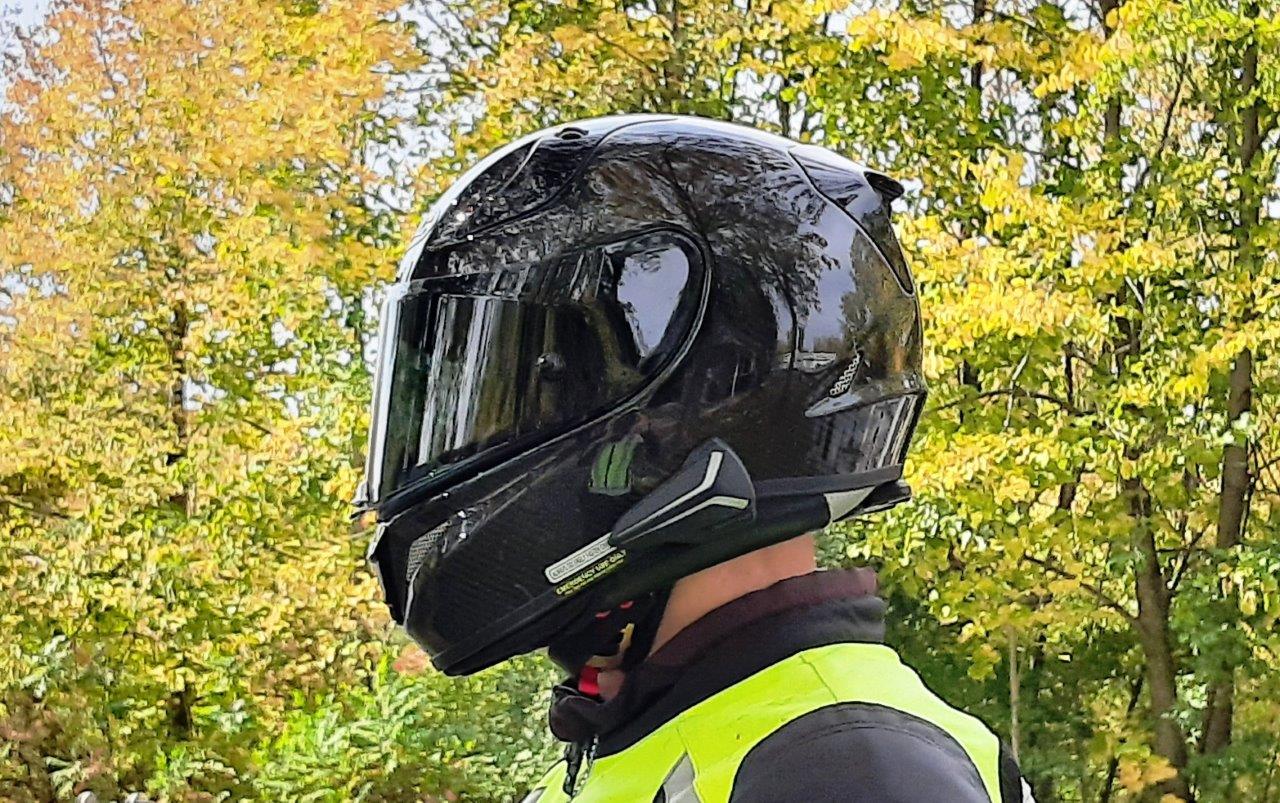

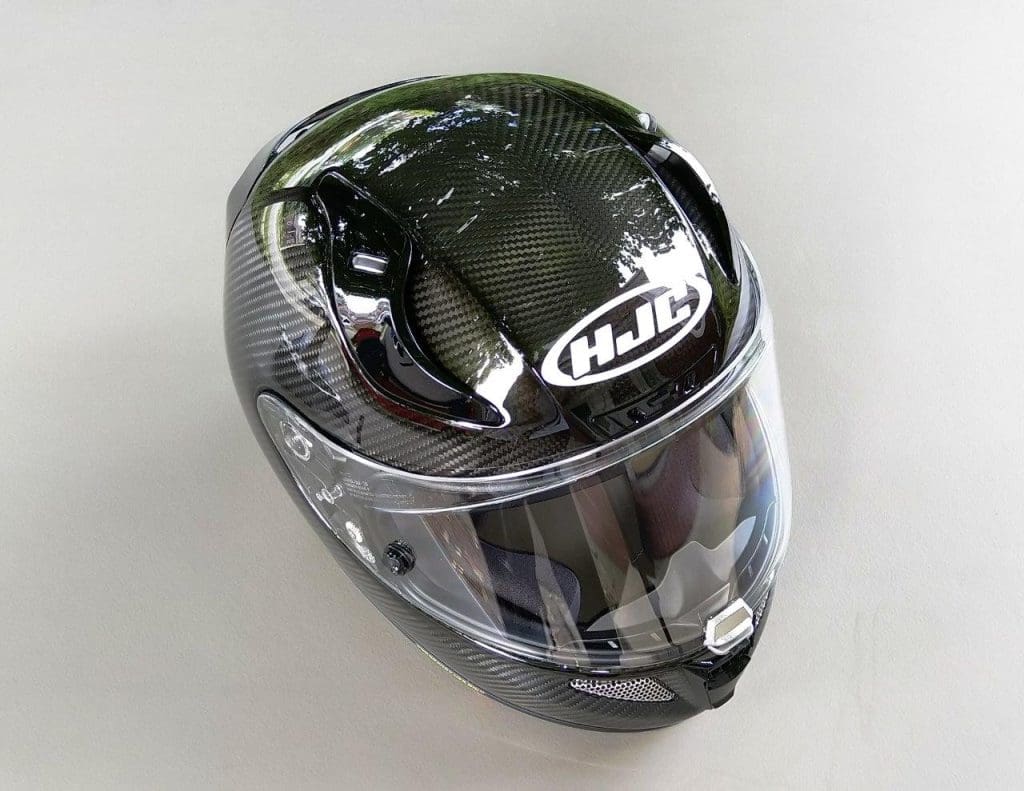

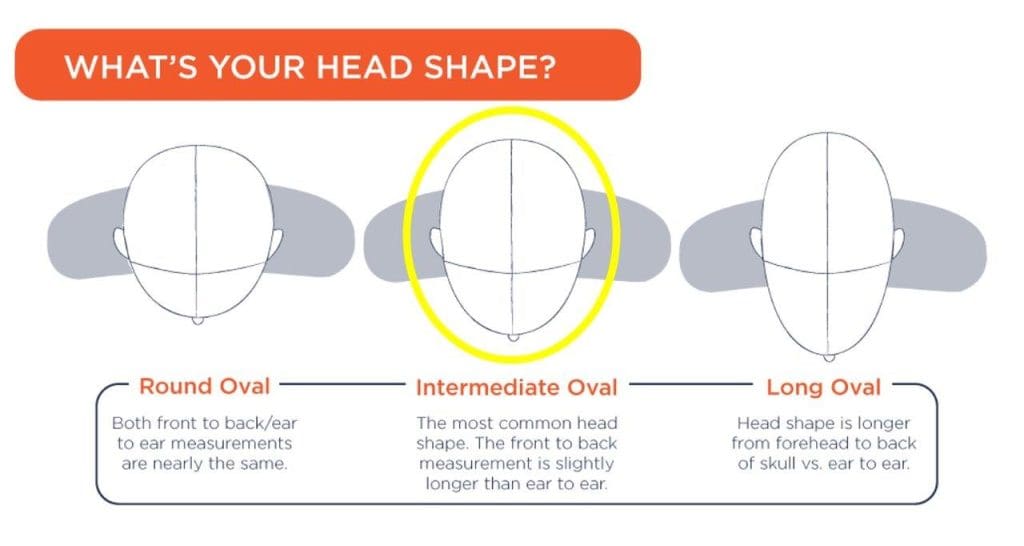
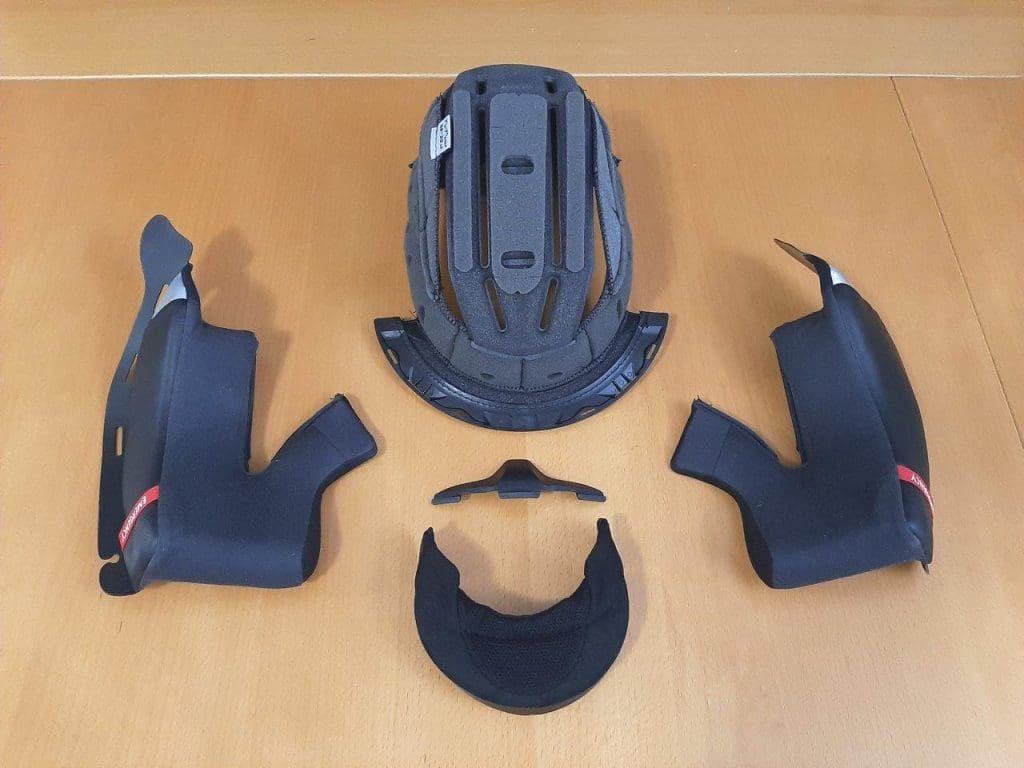
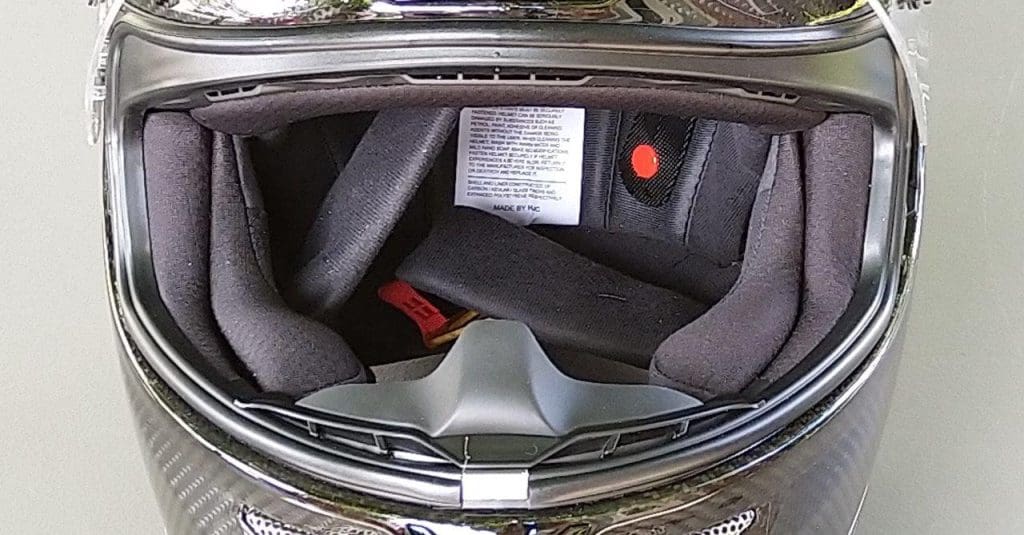
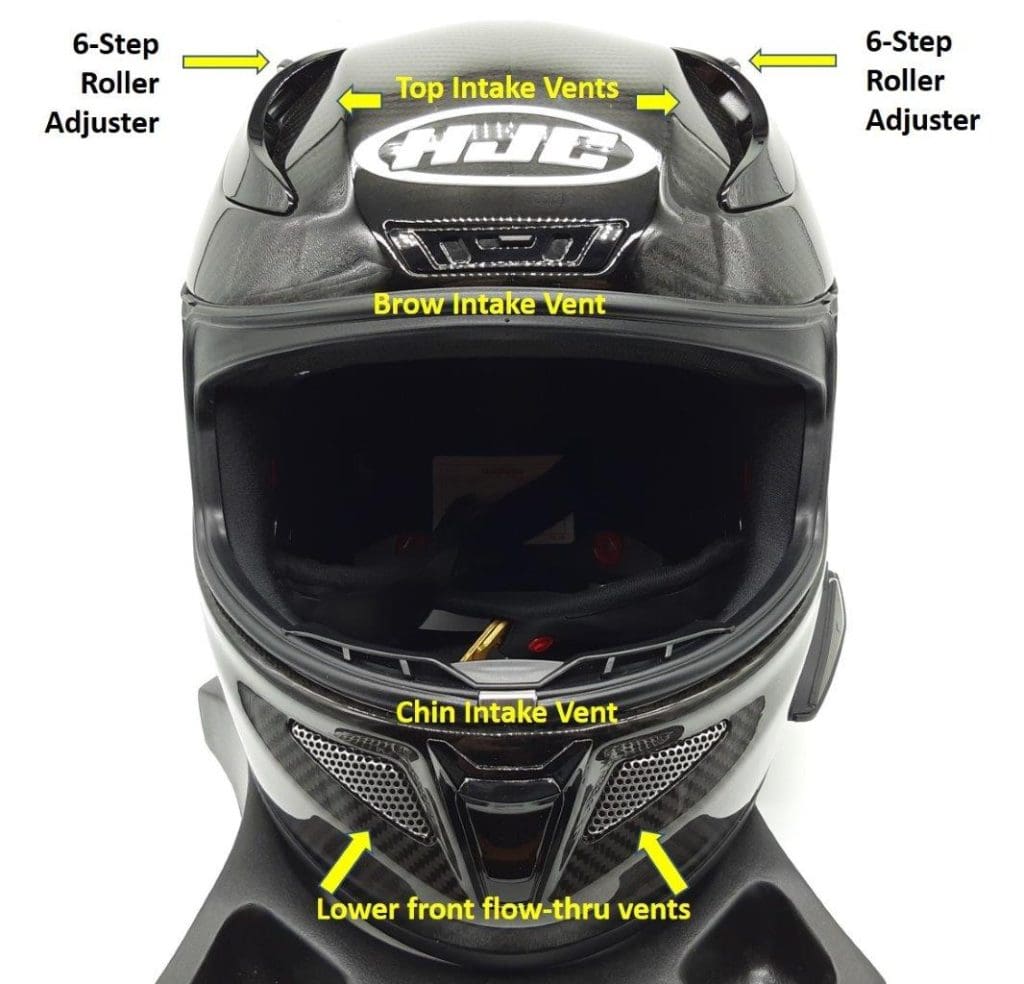
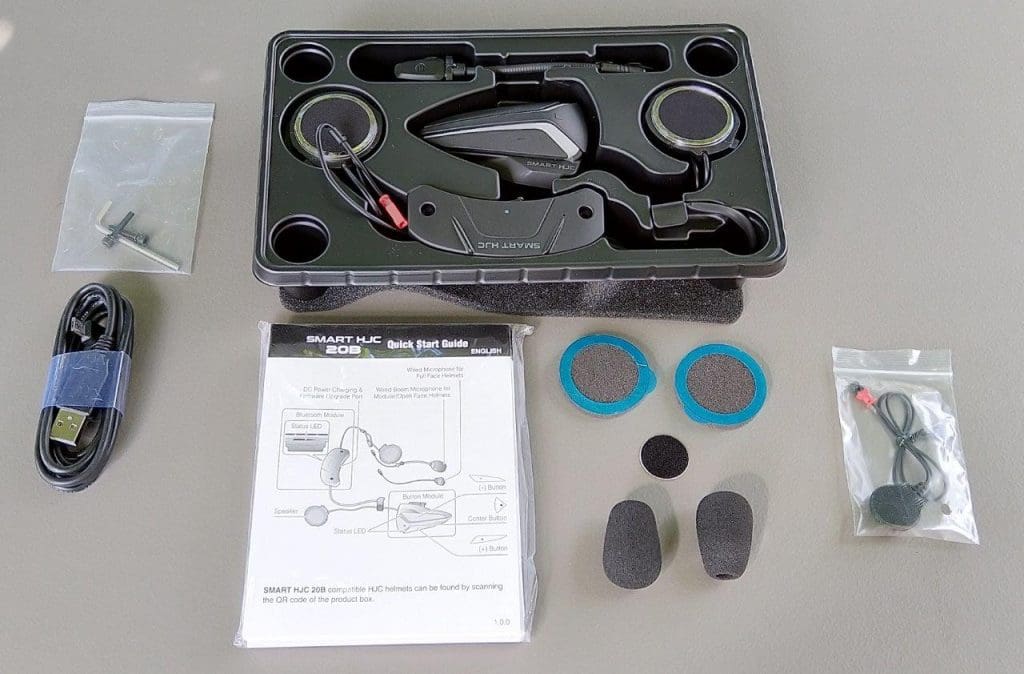
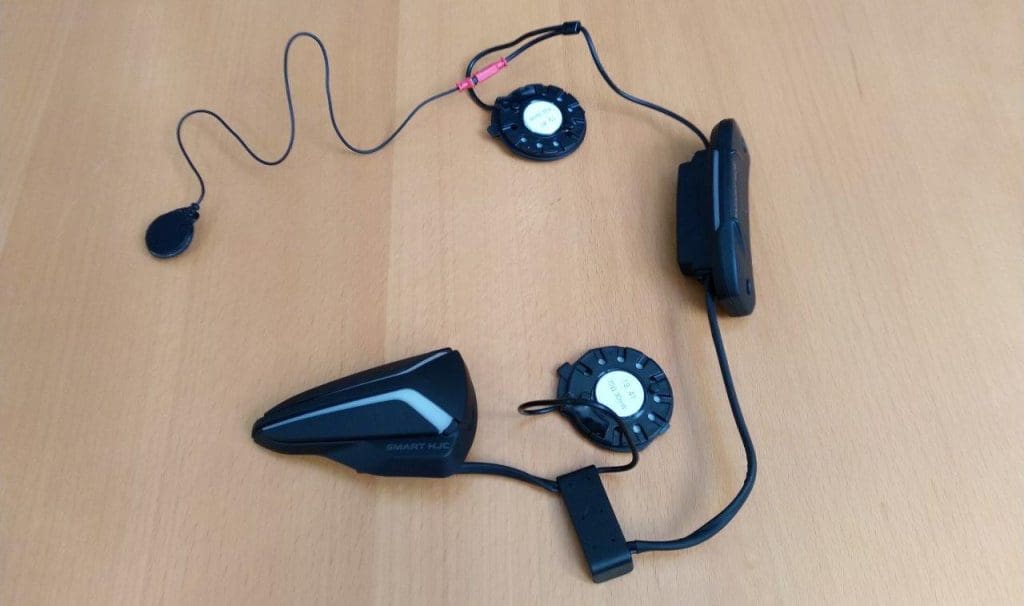
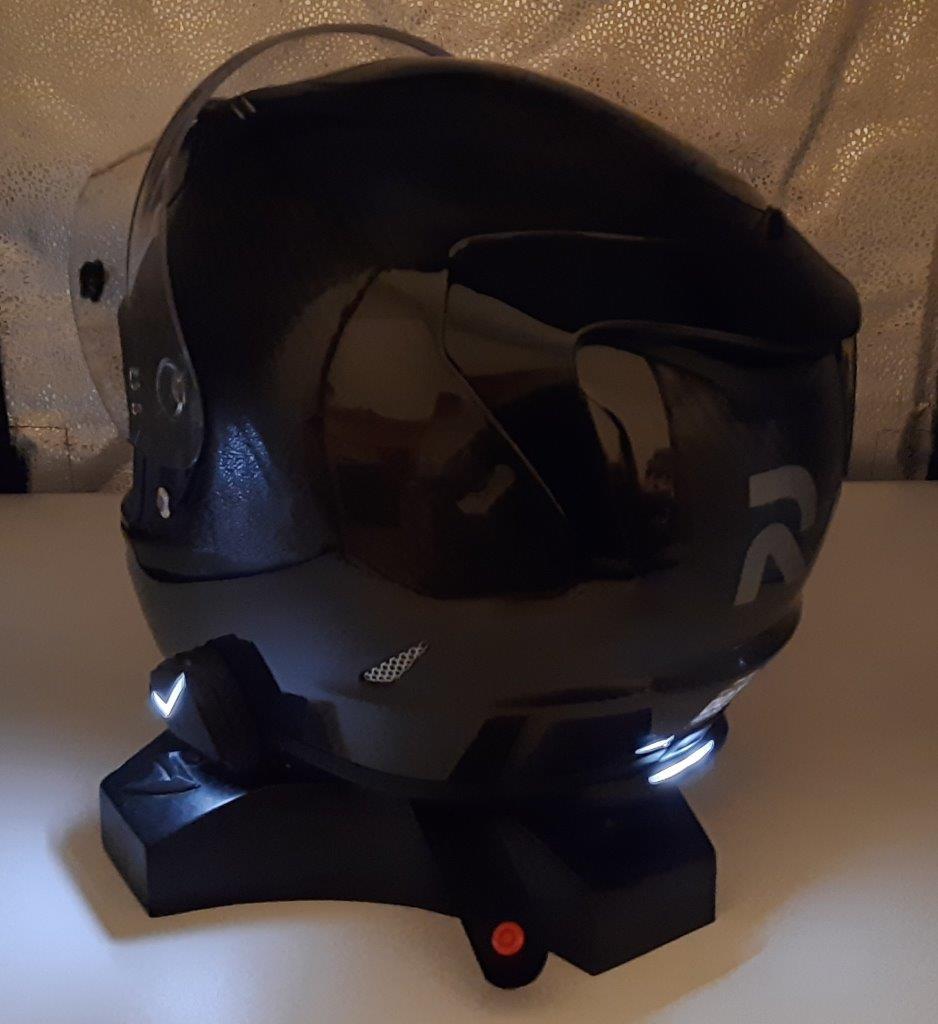
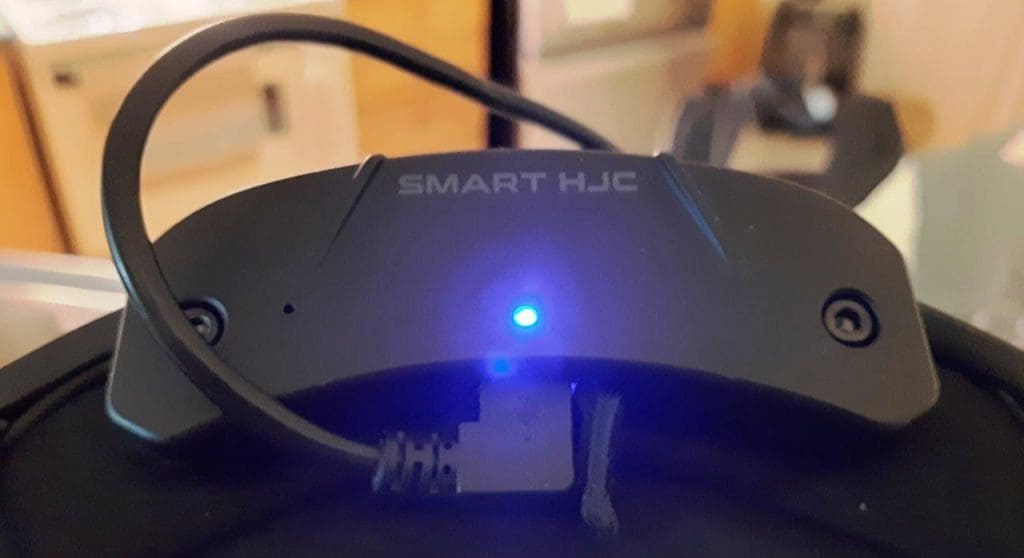

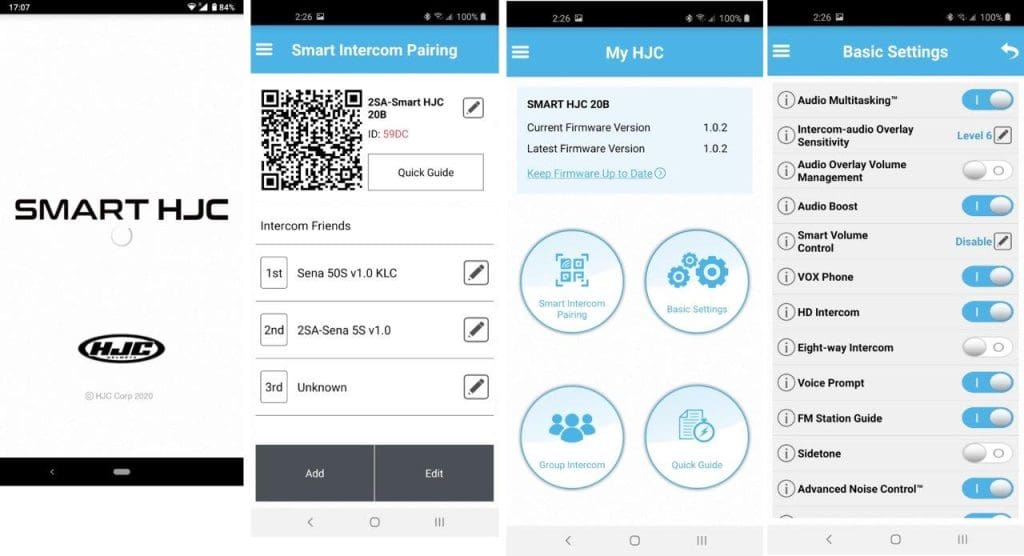
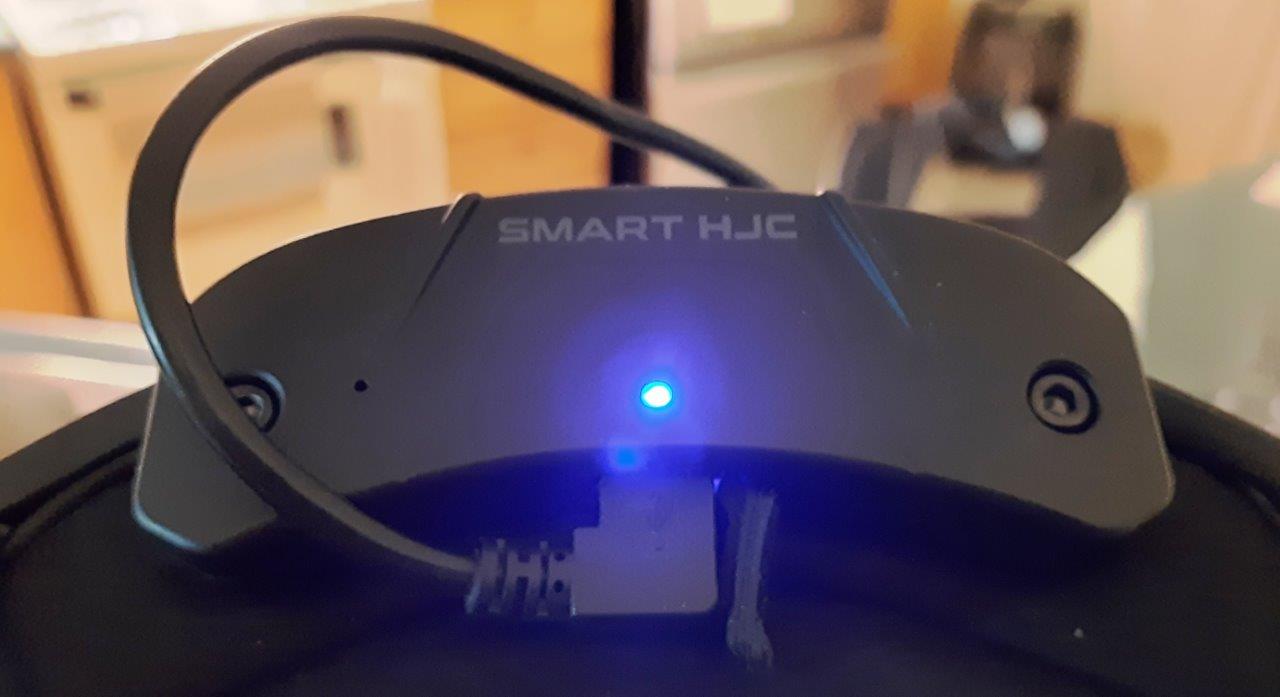
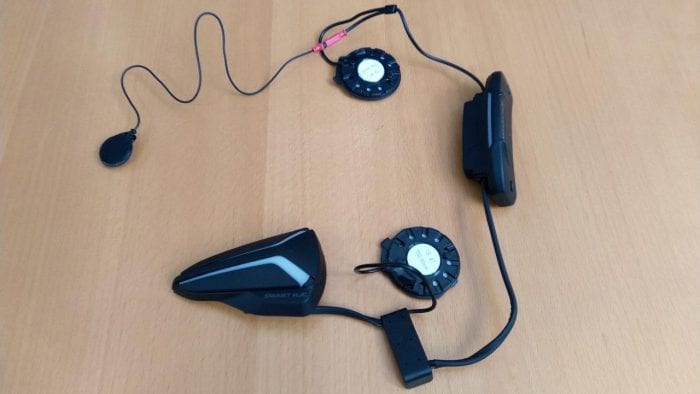
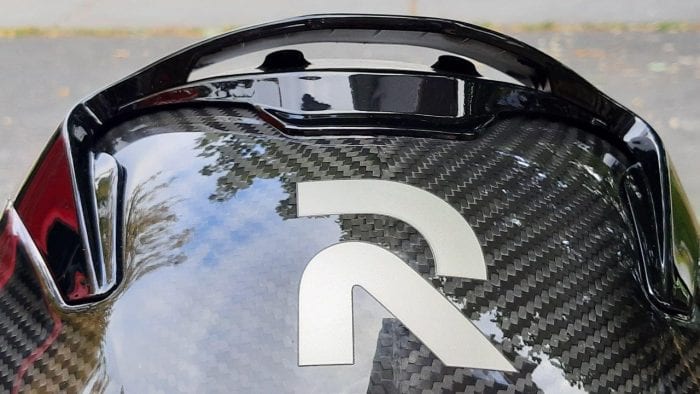
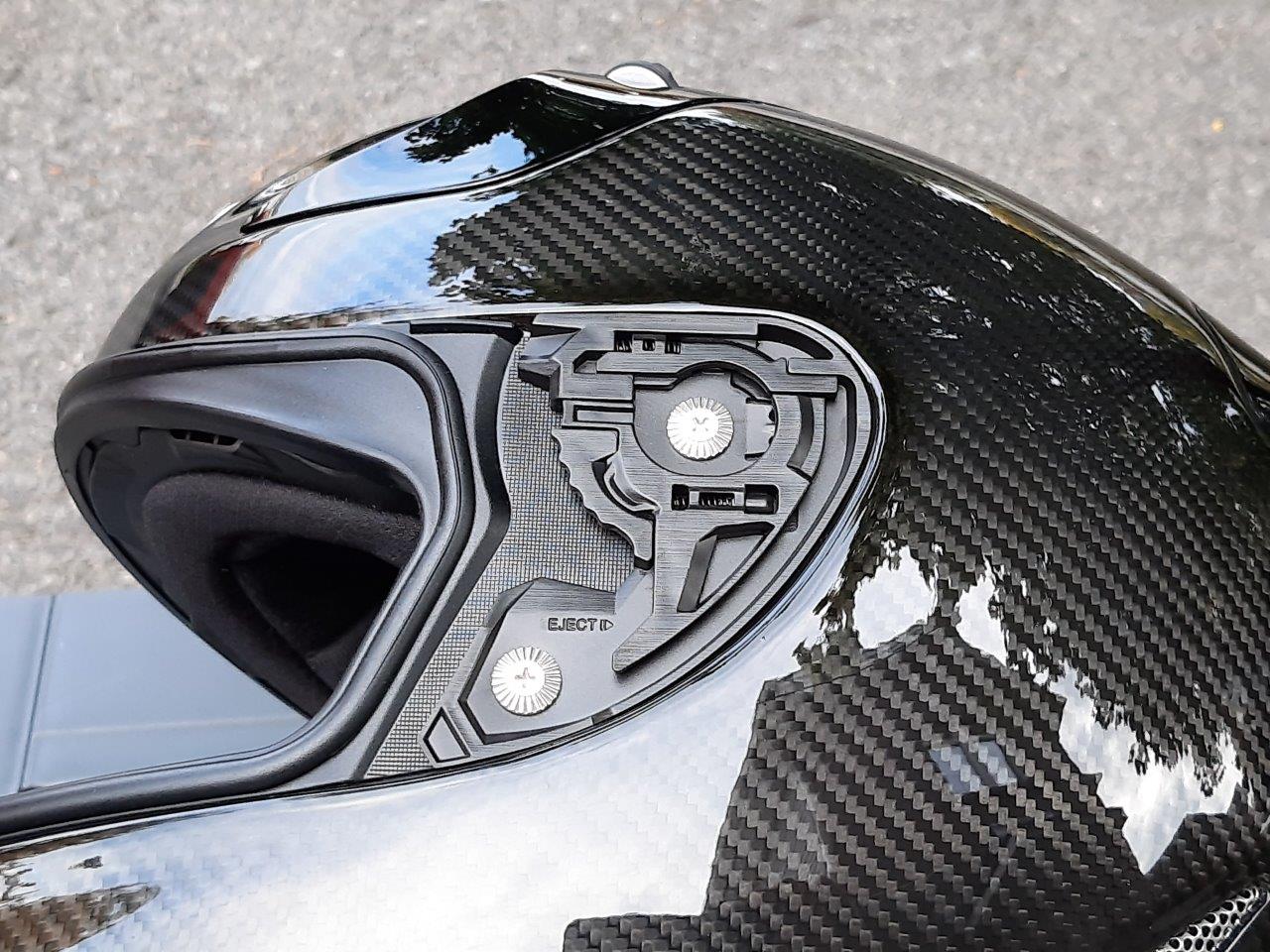
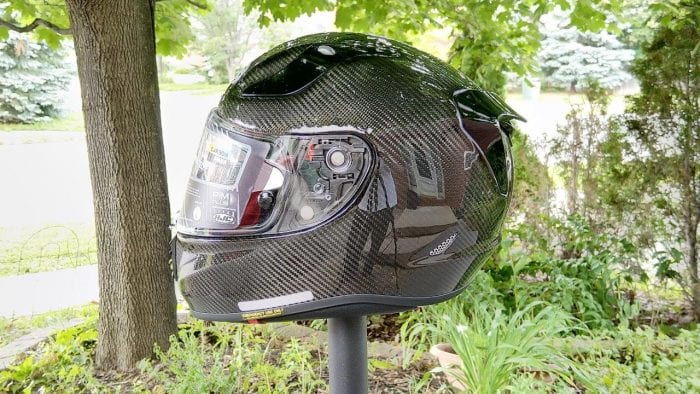
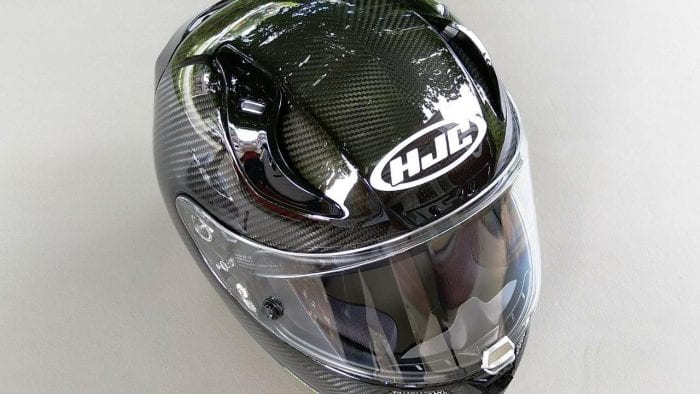
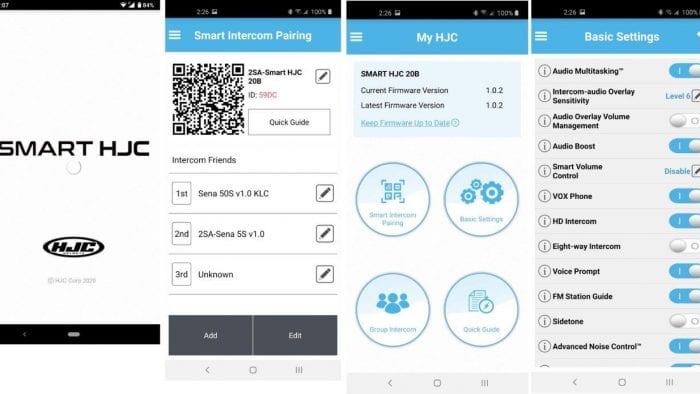

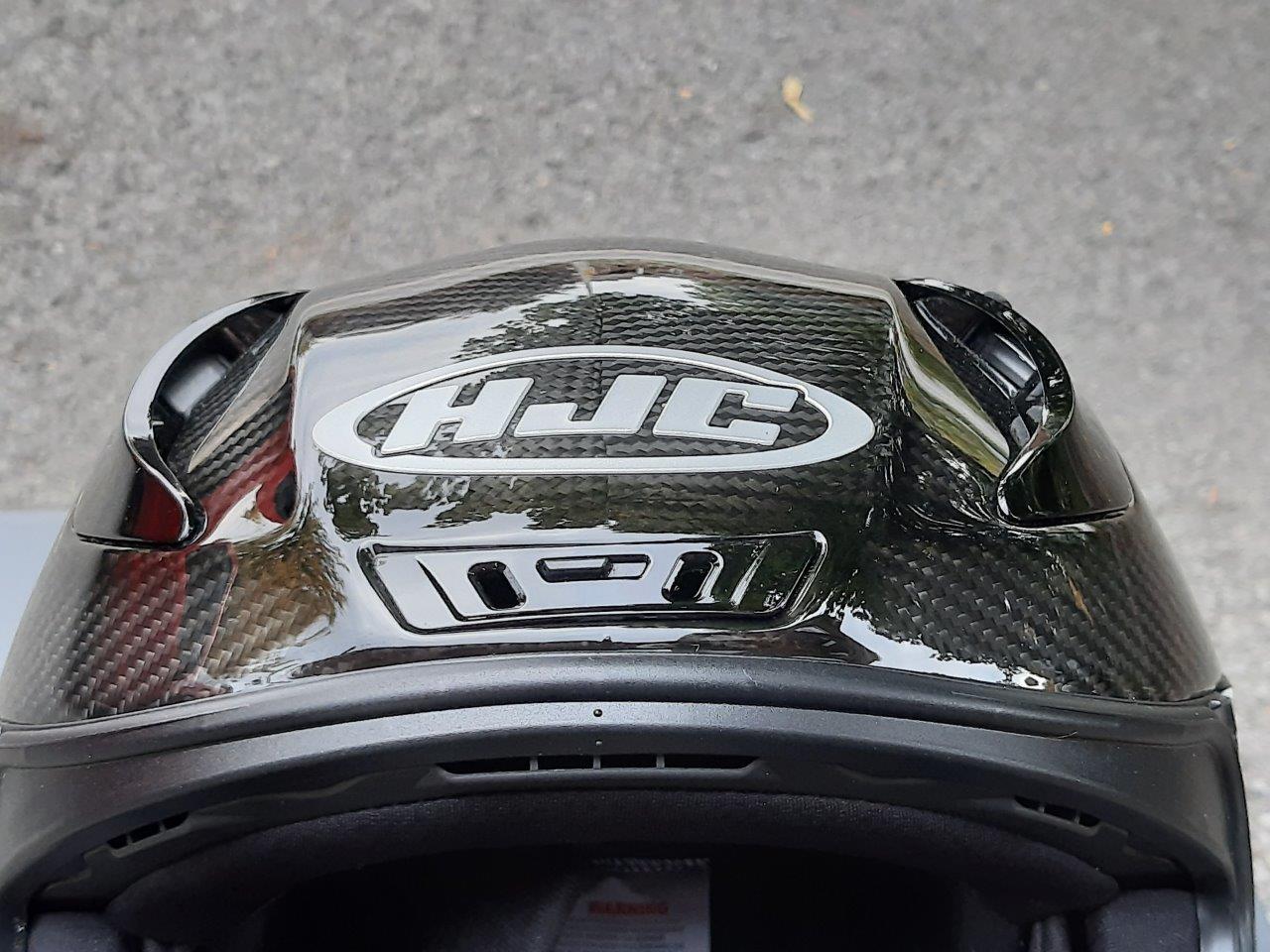
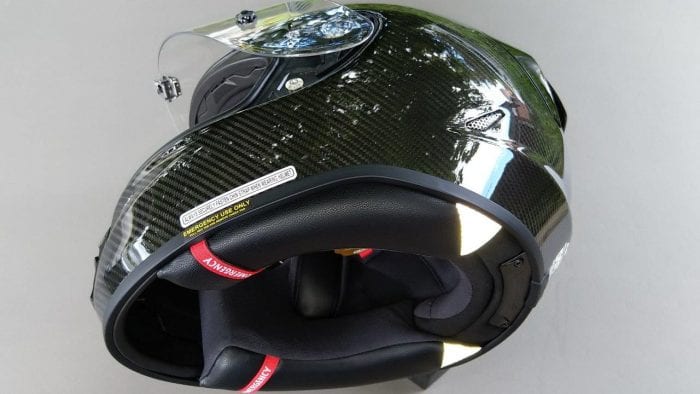
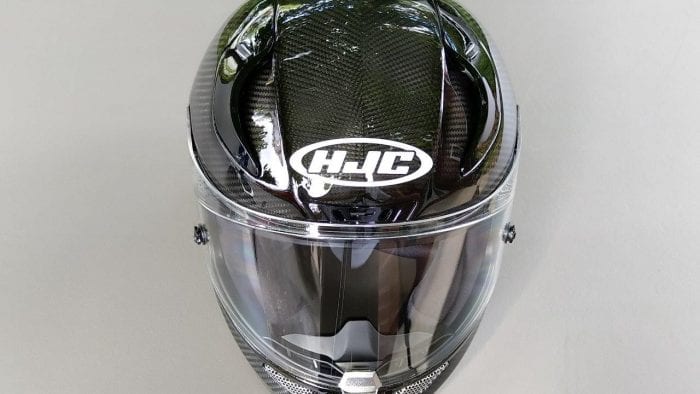
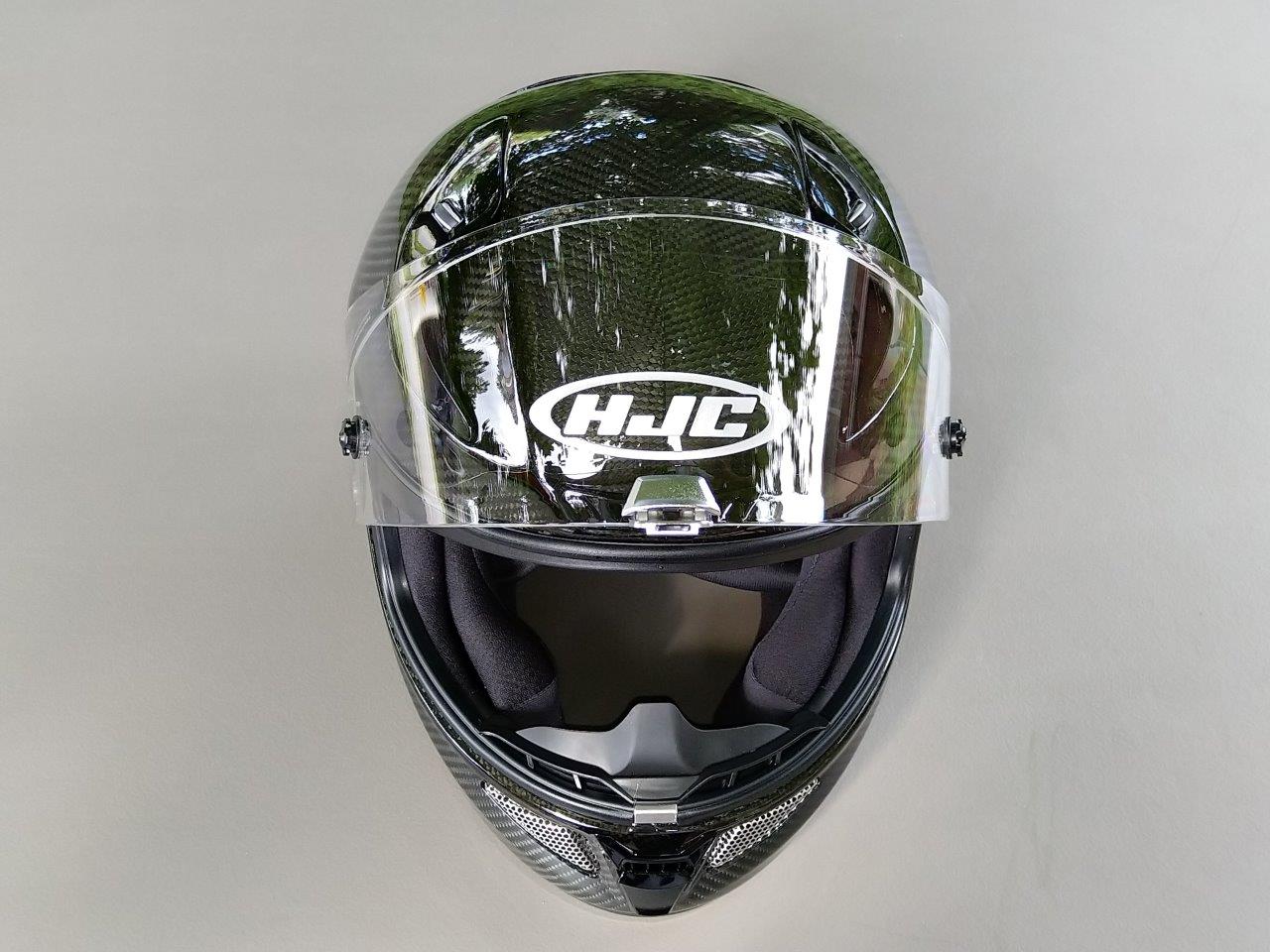
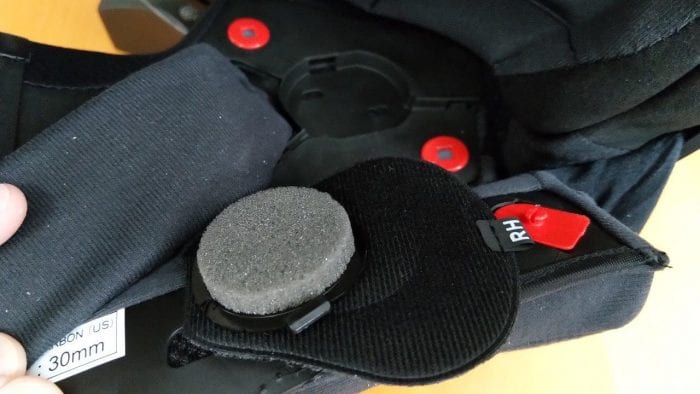
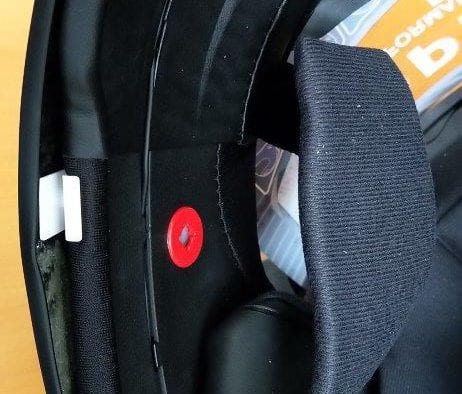
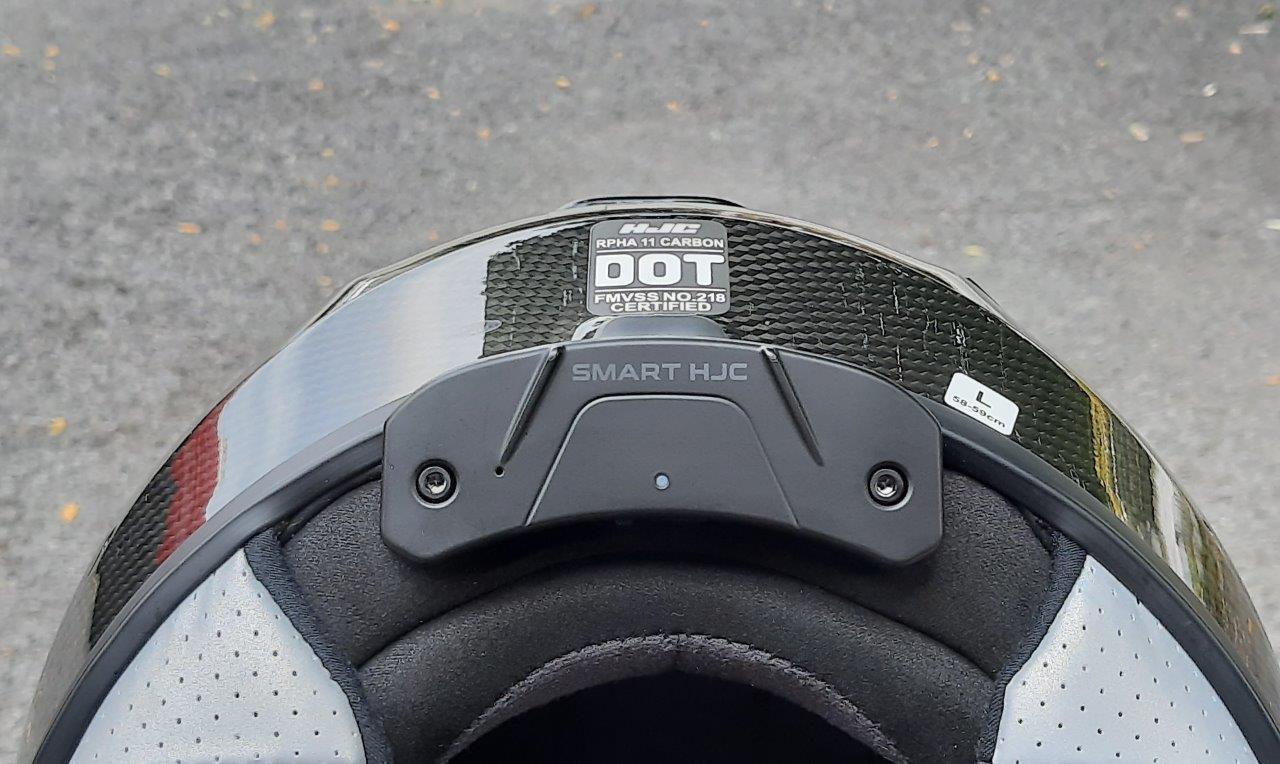
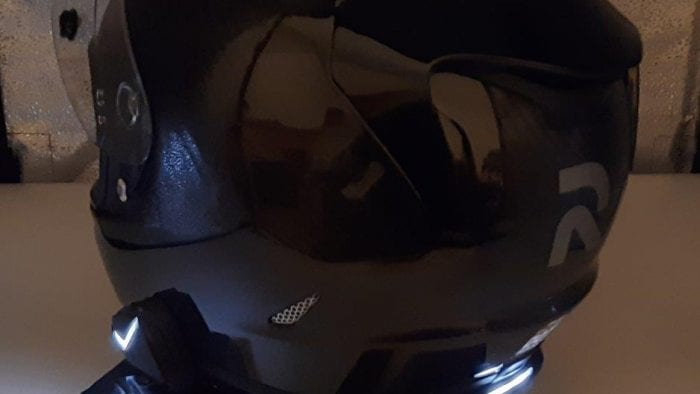

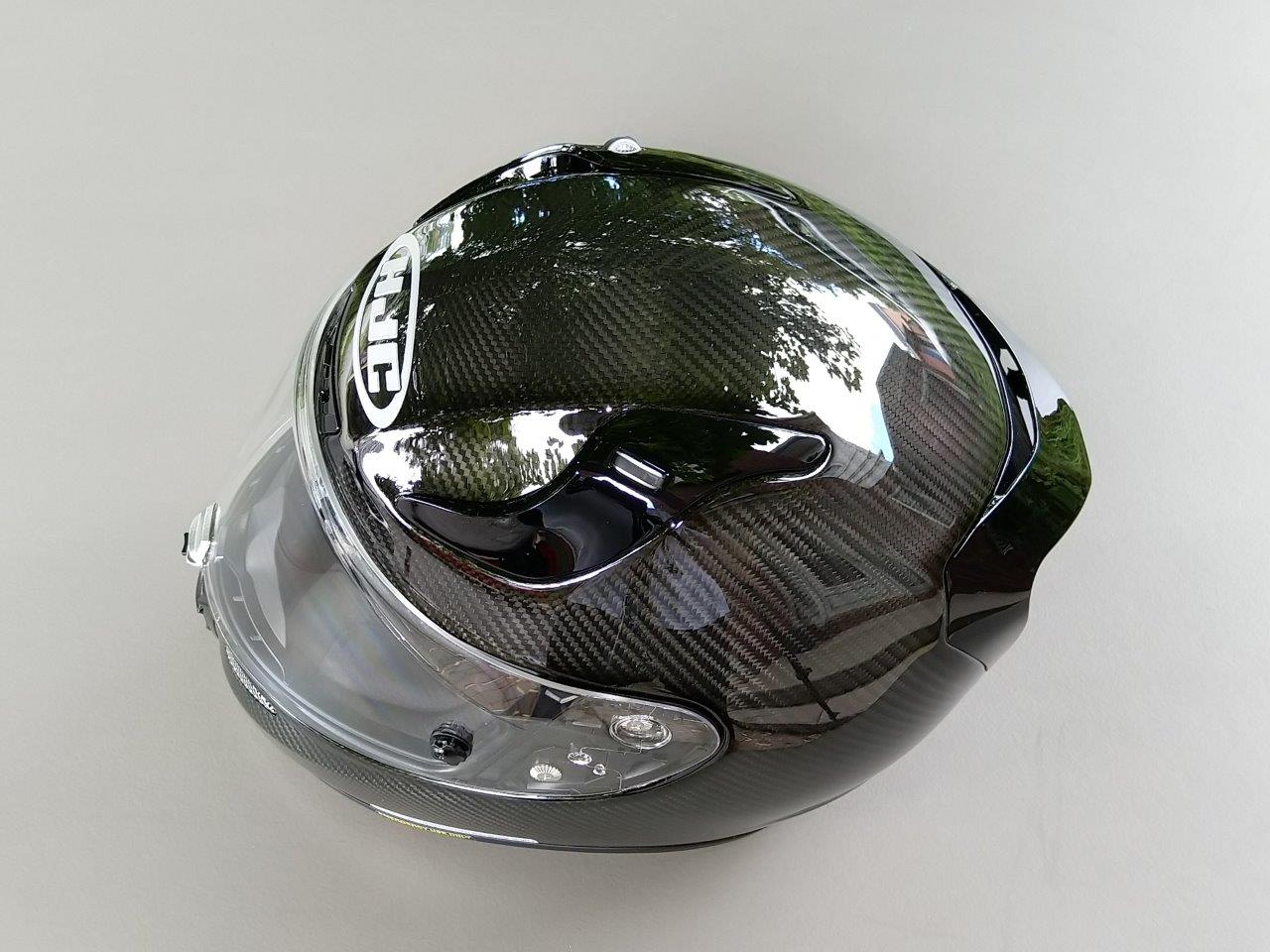
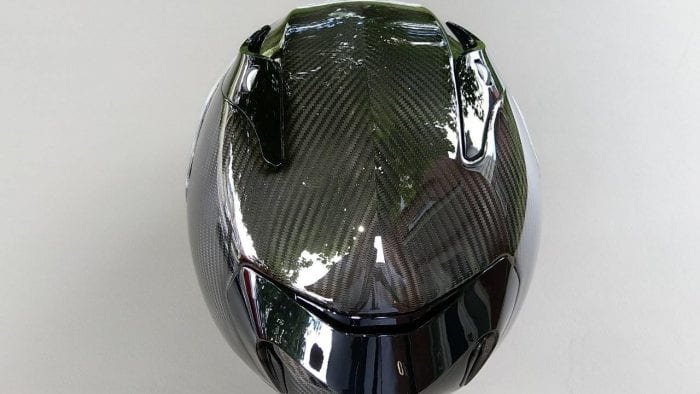


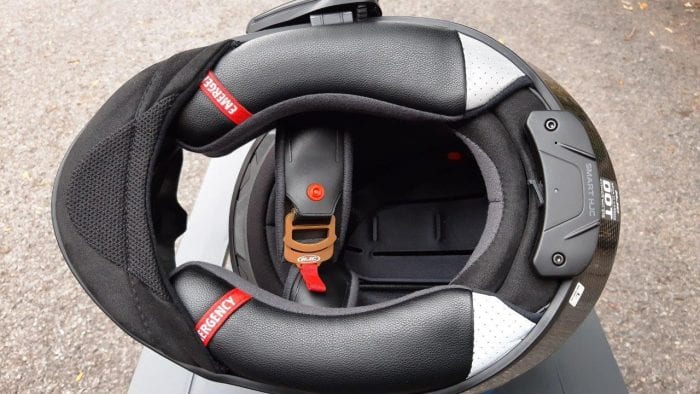
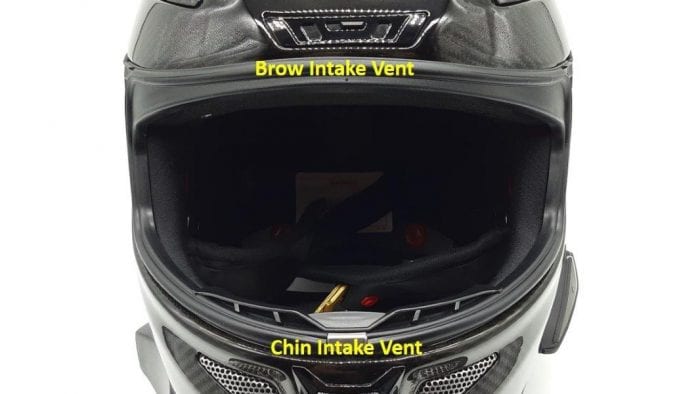
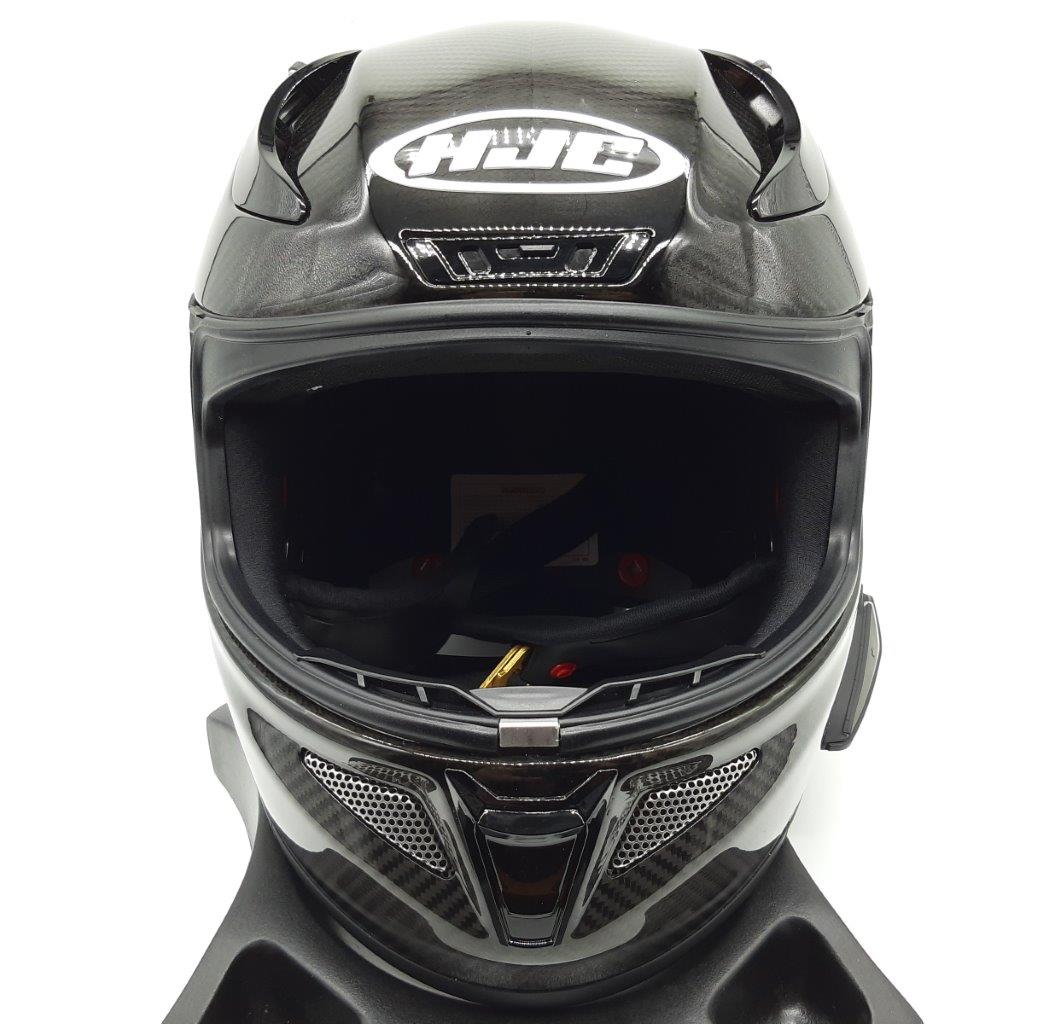
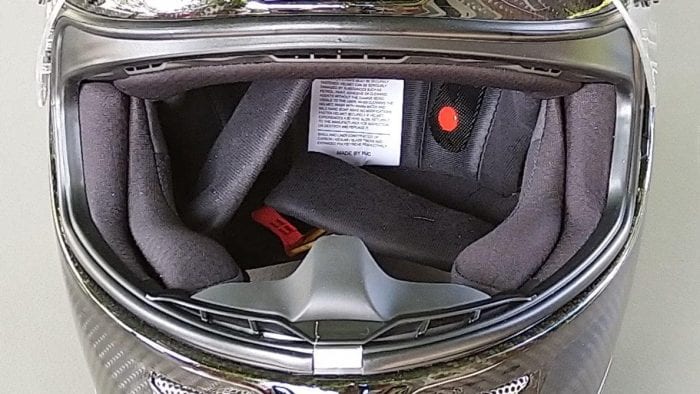

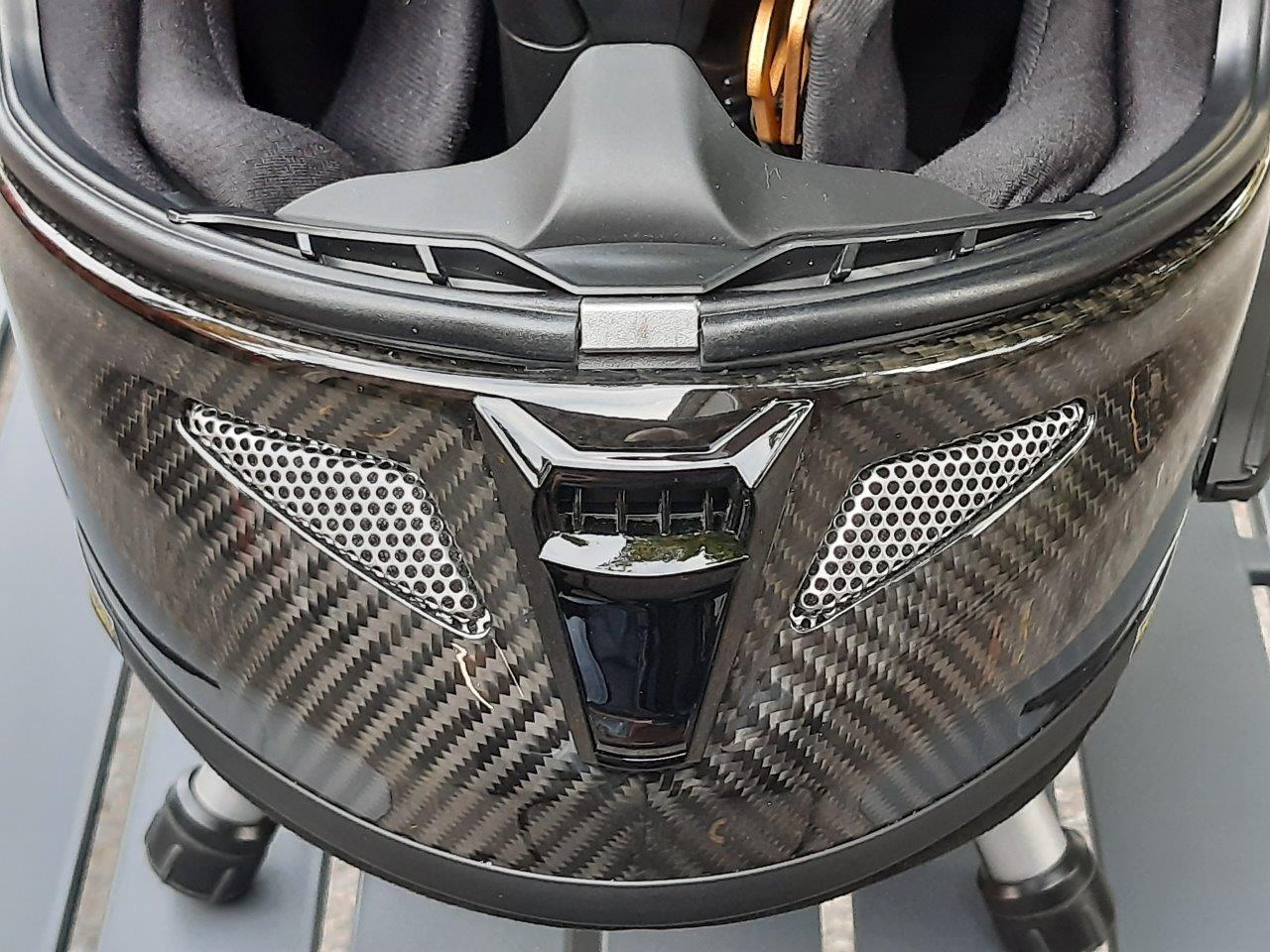
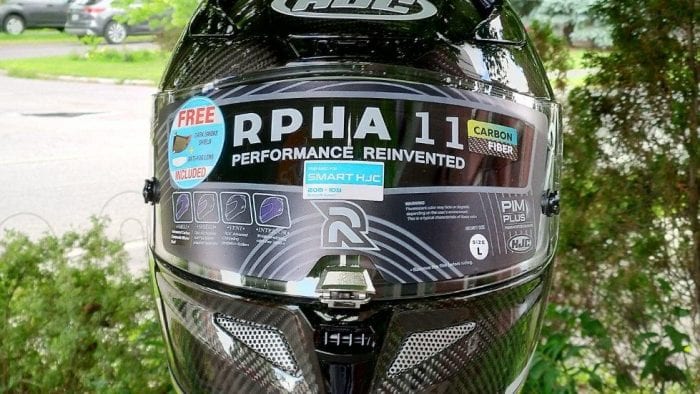
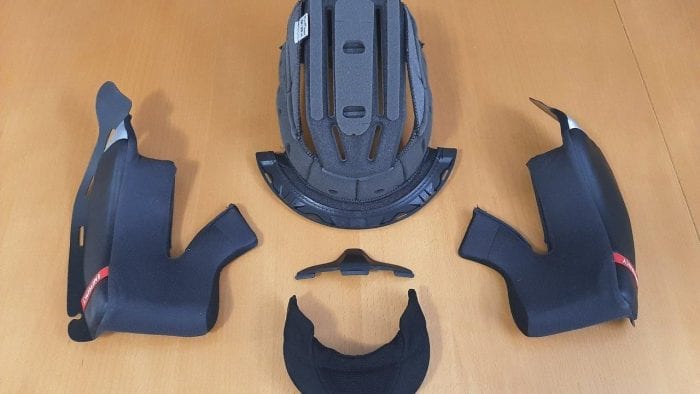



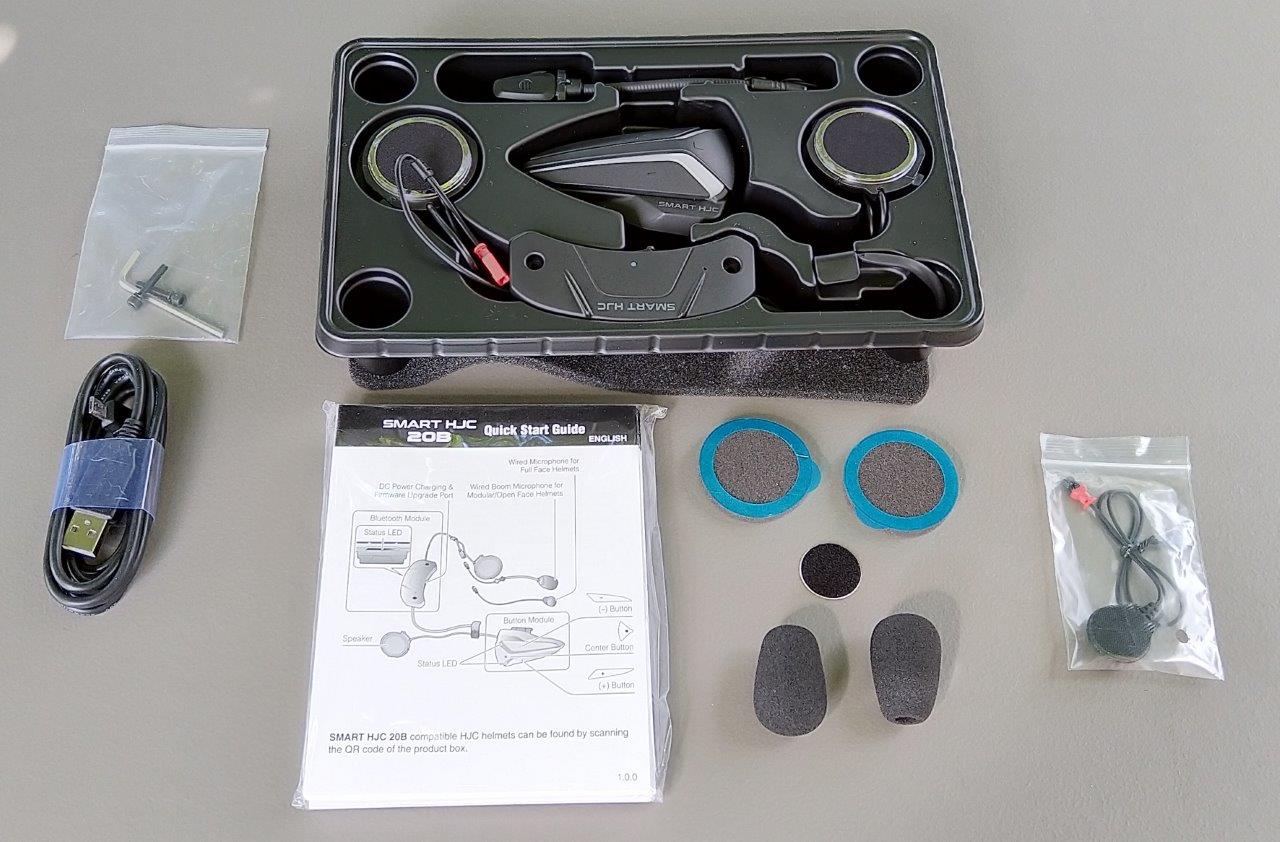
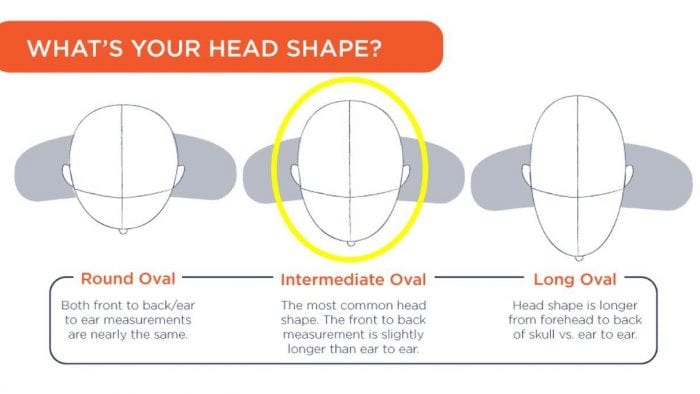
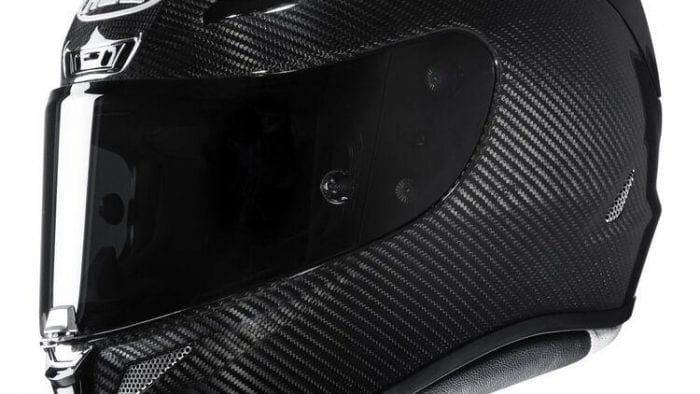


Hey Bruce!
After reading your excellent, thorough review, and your comments/praise regarding this premium helmet, I was wondering why this TOL, ca. $500 sport helmet, and the other non-Carbon versions (incl. the MotoGP replica’s) is not SNELL-rated? I was dismayed to see a HJC’s TOL helmet (or any helmet at that price-point) without a SNELL rating, especially for a company that produces helmets for, and sponsors racers at, the pinnacle of the sport.
Regards,
Kevin
Hey!
First of all, excellent review! I have three questions, regarding the helmet and the intercom device:
– Is there any diference between this carbon helmet and a “regular” RPHA 11 helmet? The weight difference is not significant.
– Will this work on my intercom RPHA 11 (not carbon) helmet?
– What are the main differences between this intercom and the Cardo Packtalk Slim? Regarding the sound quality and their functionalities.
Thank you,
André
Not 6 intake vents on the carbon version.
Please update your article.
The two front metal mesh chin vents are not functional because of the microphone cutout molding.
The normal rpha 11 pro uses those vents and has a switch inside to control them.
On the carbon version, they are just for show.
Please update your review.
(I don’t know why nobody is bringing this up !)